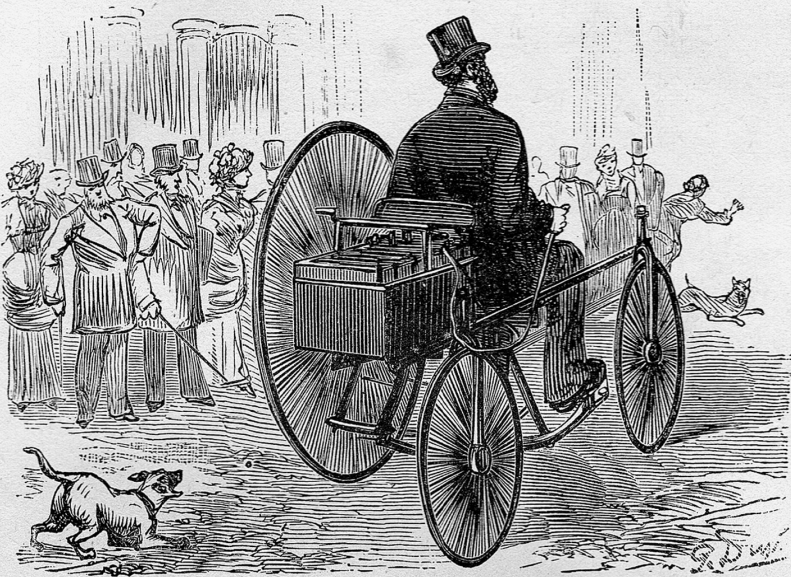
しびれる電気自動車にしびれる
We are carried by
Numbring Electric vehicle, EV

Gustave
Trouvé's personal electric vehicle (1881), the world's first publicly
presented full-scale electric car powered by an improved Siemens motor
【注意:ちゅうい】電気自動車は、electric carで、electric vehicle (EV)とよばれているのは(飛行機やドローンなどを含む)電気駆動の乗り物のことです。
| An electric car or
electric vehicle (EV) is a passenger automobile that is propelled by an
electric traction motor, using electrical energy as the primary source
of propulsion. The term normally refers to a plug-in electric vehicle,
typically a battery electric vehicle (BEV), which only uses energy
stored in on-board battery packs, but broadly may also include plug-in
hybrid electric vehicle (PHEV), range-extended electric vehicle (REEV)
and fuel cell electric vehicle (FCEV), which can convert electric power
from other fuels via a generator or a fuel cell. Compared to conventional internal combustion engine (ICE) vehicles, electric cars are quieter, more responsive, have superior energy conversion efficiency and no exhaust emissions, as well as a lower overall carbon footprint from manufacturing to end of life[1][2] (even when a power plant supplying the electricity might add to its emissions). Due to the superior efficiency of electric motors, electric cars also generate less waste heat, thus reducing the need for engine cooling systems that are often large, complicated and maintenance-prone in ICE vehicles. The electric vehicle battery typically needs to be plugged into a mains electricity power supply for recharging in order to maximize the cruising range. Recharging an electric car can be done at different kinds of charging stations; these charging stations can be installed in private homes, parking garages and public areas.[3] There is also research and development in, as well as deployment of, other technologies such as battery swapping and inductive charging. As the recharging infrastructure (especially fast chargers) is still in its infancy, range anxiety and time cost are frequent psychological obstacles during consumer purchasing decisions against electric cars. Worldwide, 14 million plug-in electric cars were sold in 2023, 18% of new car sales, up from 14% in 2022.[4] Many countries have established government incentives for plug-in electric vehicles, tax credits, subsidies, and other non-monetary incentives while several countries have legislated to phase-out sales of fossil fuel cars,[5][6] to reduce air pollution and limit climate change.[7][8] EVs are expected to account for over one-fifth of global car sales in 2024.[4] China currently has the largest stock of electric vehicles in the world, with cumulative sales of 5.5 million units through December 2020,[9][needs update] although these figures also include heavy-duty commercial vehicles such as buses, garbage trucks and sanitation vehicles, and only accounts for vehicles manufactured in China.[10][11][12][13][14][15] In the United States and the European Union, as of 2020, the total cost of ownership of recent electric vehicles is cheaper than that of equivalent ICE cars, due to lower fueling and maintenance costs.[16][17] In 2023, the Tesla Model Y became the world's best selling car.[18] The Tesla Model 3 became the world's all-time best-selling electric car in early 2020,[19] and in June 2021 became the first electric car to pass 1 million global sales.[20] Together with other emerging automotive technologies such as autonomous driving, connected vehicles and shared mobility, electric cars form a future mobility vision called Autonomous, Connected, Electric and Shared (ACES) Mobility.[21][page needed] |
電気自動車または電気自動車(EV)は、電気エネルギーを主な推進源と
して電気牽引モーターで推進する乗用車である。この用語は通常、プラグイン電気自動車を指し、通常は車載バッテリーパックに蓄えられたエネルギーだけを使
用するバッテリー電気自動車(BEV)であるが、広義にはプラグインハイブリッド電気自動車(PHEV)、航続距離延長型電気自動車(REEV)、発電機
や燃料電池を介して他の燃料から電力を変換できる燃料電池電気自動車(FCEV)も含まれる。 従来の内燃機関(ICE, Internal Combustion Engine)車と比較すると、電気自動車は静かで応答性が高く、エネルギー変換効率に優れ、排気ガスが出ないだけでなく、製造から使用後 [1][2]までの全体的な二酸化炭素排出量も少ない(電気を供給する発電所が排出量を増やす可能性がある場合でも)。電気モーターの効率が優れているた め、電気自動車は廃熱の発生も少なく、ICE車では大型で複雑でメンテナンスが必要になりがちなエンジン冷却システムの必要性を減らすことができる。 電気自動車のバッテリーは通常、航続距離を格律するために主電源に接続して充電する必要がある。電気自動車の充電は、異なる種類の充電ステーションで行う ことができる。これらの充電ステーションは、個人宅、駐車場、公共エリアに設置することができる。充電インフラ(特に急速充電器)はまだ発展途上であるた め、航続距離への不安と時間的コストは、消費者が電気自動車を購入する際の心理的障害となることが多い。 世界では、2023年には1,400万台のプラグイン電気自動車が販売され、新車販売の18%を占め、2022年の14%から増加した[4]。多くの国 が、プラグイン電気自動車に対する政府のインセンティブ、税額控除、補助金、その他の非金銭的インセンティブを確立している一方で、いくつかの国は、大気 汚染を削減し、気候変動を抑制するために、化石燃料自動車の販売を段階的に廃止することを法律で定めている[5][6]。2024年には、EVが世界の自 動車販売の5分の1以上を占めるようになると予想されている[4]。 中国は現在、世界最大の電気自動車ストックを有しており、2020年12月までの累計販売台数は550万台である[9][要更新]。ただし、この数字には バス、ゴミ収集車、衛生車などの大型商用車も含まれており、中国国内で製造された車両のみを対象としている[10][11][12][13][14] [15]。米国と欧州連合では、2020年時点で、最近の電気自動車の総所有コストは、燃料費とメンテナンスコストが低いため、同等のICE車よりも安く なっている[16][17]。 2023年、テスラ・モデルYは世界で最も売れている自動車となった[18]。テスラ・モデル3は2020年初めに世界で最も売れている電気自動車となり [19]、2021年6月には電気自動車として初めて世界販売台数100万台を突破した[20]。自律走行、コネクテッド・ビークル、シェアード・モビリ ティといった他の新たな自動車技術とともに、電気自動車は自律・コネクテッド・エレクトリック・シェアード(ACES)モビリティと呼ばれる将来のモビリ ティ・ビジョンを形成している[21][要ページ]。 |
| Terminology See also: Vehicle classification by propulsion system, Plug-in electric vehicle § Terminology, and Battery electric vehicle The term "electric car" typically refers specifically to battery electric vehicles (BEVs) or all-electric cars, a type of electric vehicle (EV) that has an onboard rechargeable battery pack that can be plugged in and charged from the electric grid, and the electricity stored on the vehicle is the only energy source that provide propulsion for the wheels. The term generally refers to highway-capable automobiles, but there are also low-speed electric vehicles with limitations in terms of weight, power, and maximum speed that are allowed to travel on certain public roads. The latter are classified as Neighborhood Electric Vehicles (NEVs) in the United States,[22] and as electric motorised quadricycles in Europe.[23] |
用語解説 以下も参照のこと: 推進システムによる車両分類、プラグイン電気自動車§用語、バッテリー電気自動車も参照のこと。 「電気自動車」という用語は、一般的にバッテリー電気自動車(BEV)またはオール・エレクトリック・カーを特に指す。このタイプの電気自動車(EV) は、充電可能なバッテリー・パックを搭載しており、電気グリッドに接続して充電することができる。一般的には高速道路を走行可能な自動車を指すが、重量、 出力、最高速度に制限のある低速の電気自動車もあり、特定の公道での走行が認められている。後者は、米国では近隣電気自動車(NEV)として分類され [22]、欧州では電動四輪車として分類されている[23]。 |
| History Main article: History of the electric vehicle Early developments Robert Anderson is often credited with inventing the first electric car some time between 1832 and 1839.[24] The following experimental electric cars appeared during the 1880s:  In 1881, Gustave Trouvé presented an electric car driven by an improved Siemens motor at the Exposition internationale d'Électricité de Paris.[25] In 1884, Thomas Parker built an electric car in Wolverhampton, England using his own specially-designed high-capacity rechargeable batteries, although the only documentation is a photograph from 1895.[26][27][28] In 1888, the German Andreas Flocken designed the Flocken Elektrowagen, regarded by some as the first "real" electric car.[29][30][31] In 1890, Andrew Morrison introduced the first electric car to the United States.[32] Electricity was among the preferred methods for automobile propulsion in the late 19th and early 20th centuries, providing a level of comfort and an ease of operation that could not be achieved by the gasoline-driven cars of the time.[33] The electric vehicle fleet peaked at approximately 30,000 vehicles at the turn of the 20th century.[34] In 1897, electric cars first found commercial use as taxis in Britain and in the United States. In London, Walter Bersey's electric cabs were the first self-propelled vehicles for hire at a time when cabs were horse-drawn.[35] In New York City, a fleet of twelve hansom cabs and one brougham, based on the design of the Electrobat II, formed part of a project funded in part by the Electric Storage Battery Company of Philadelphia.[36] During the 20th century, the main manufacturers of electric vehicles in the United States included Anthony Electric, Baker, Columbia, Anderson, Edison, Riker, Milburn, Bailey Electric, and Detroit Electric. Their electric vehicles were quieter than gasoline-powered ones, and did not require gear changes.[37][38] 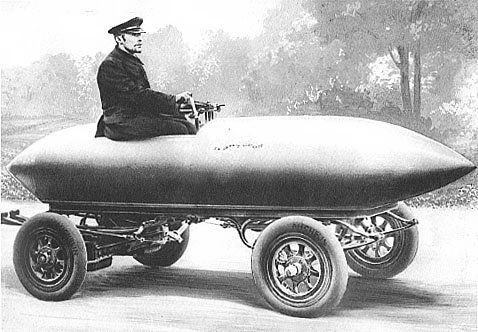 Six electric cars held the land speed record in the 19th century.[39] The last of them was the rocket-shaped La Jamais Contente, driven by Camille Jenatzy, which broke the 100 km/h (62 mph) speed barrier by reaching a top speed of 105.88 km/h (65.79 mph) in 1899. Electric cars remained popular until advances in internal-combustion engine (ICE) cars and mass production of cheaper gasoline- and diesel-powered vehicles, especially the Ford Model T, led to a decline.[32] ICE cars' much quicker refueling times and cheaper production costs made them more popular. However, a decisive moment came with the introduction in 1912 of the electric starter motor[40] that replaced other, often laborious, methods of starting the ICE, such as hand-cranking. |
歴史 主な記事 電気自動車の歴史 初期の開発 ロバート・アンダーソンは、1832年から1839年の間に最初の電気自動車を発明したとされることが多い[24]。 1880年代には次のような実験的な電気自動車が登場した:  1881年、ギュスターヴ・トルヴェはパリ国際電気博覧会で、改良されたシーメンス製モーターで駆動する電気自動車を発表した[25]。 1884年、トーマス・パーカーはイギリスのウォルバーハンプトンで、彼自身が特別に設計した大容量の充電式電池を使って電気自動車を製造したが、唯一の 記録は1895年の写真である[26][27][28]。 1888年、ドイツのアンドレアス・フロッケンがフロッケン・エレクトロワーゲンを設計し、最初の「本物の」電気自動車と見なされている[29][30] [31]。 1890年、アンドリュー・モリソンがアメリカ初の電気自動車を発表した[32]。 電気は19世紀後半から20世紀初頭にかけて自動車の推進方法として好まれたもののひとつであり、当時のガソリン駆動の自動車では実現できなかったレベル の快適性と操作性を提供した[33]。 1897年、電気自動車はイギリスとアメリカでタクシーとして初めて商業利用された。ロンドンでは、ウォルター・ベルゼーの電気タクシーが、タクシーが馬 に引かれていた時代に最初の自走式ハイヤーであった[35]。ニューヨーク市では、エレクトロバットIIの設計に基づく12台のハンサム・タクシーと1台 のブローハムの車両が、フィラデルフィアの電気蓄電池会社によって一部資金提供されたプロジェクトの一部を構成していた[36]。 [36]20世紀には、アンソニー・エレクトリック、ベイカー、コロンビア、アンダーソン、エジソン、ライカー、ミルバーン、ベイリー・エレクトリック、 デトロイト・エレクトリックなど、アメリカにおける電気自動車の主要メーカーが存在した。彼らの電気自動車はガソリン車よりも静かで、ギアチェンジを必要 としなかった[37][38]。  19世紀には6台の電気自動車が陸上速度記録を保持していた[39]。 その最後のものは、1899年に最高速度105.88km/hを記録して時速100kmの壁を破った、カミーユ・ジェナツィが運転するロケット型のラ・ ジャメ・コンテントであった。 電気自動車は、内燃機関(ICE)自動車の進歩と、フォードT型を中心とする安価なガソリン・ディーゼルエンジン車の大量生産が衰退につながるまで、人気 を維持した[32]。しかし、1912年に電気スターターモーター[40]が導入され、手回しなど、しばしば手間のかかる他のICE始動方法に取って代わ る決定的な瞬間が訪れた。 |
 Gustave Trouvé's personal electric vehicle (1881), the world's first publicly presented full-scale electric car powered by an improved Siemens motor  The Electromote, the world's first trolleybus by Werner von Siemens, Berlin 1882 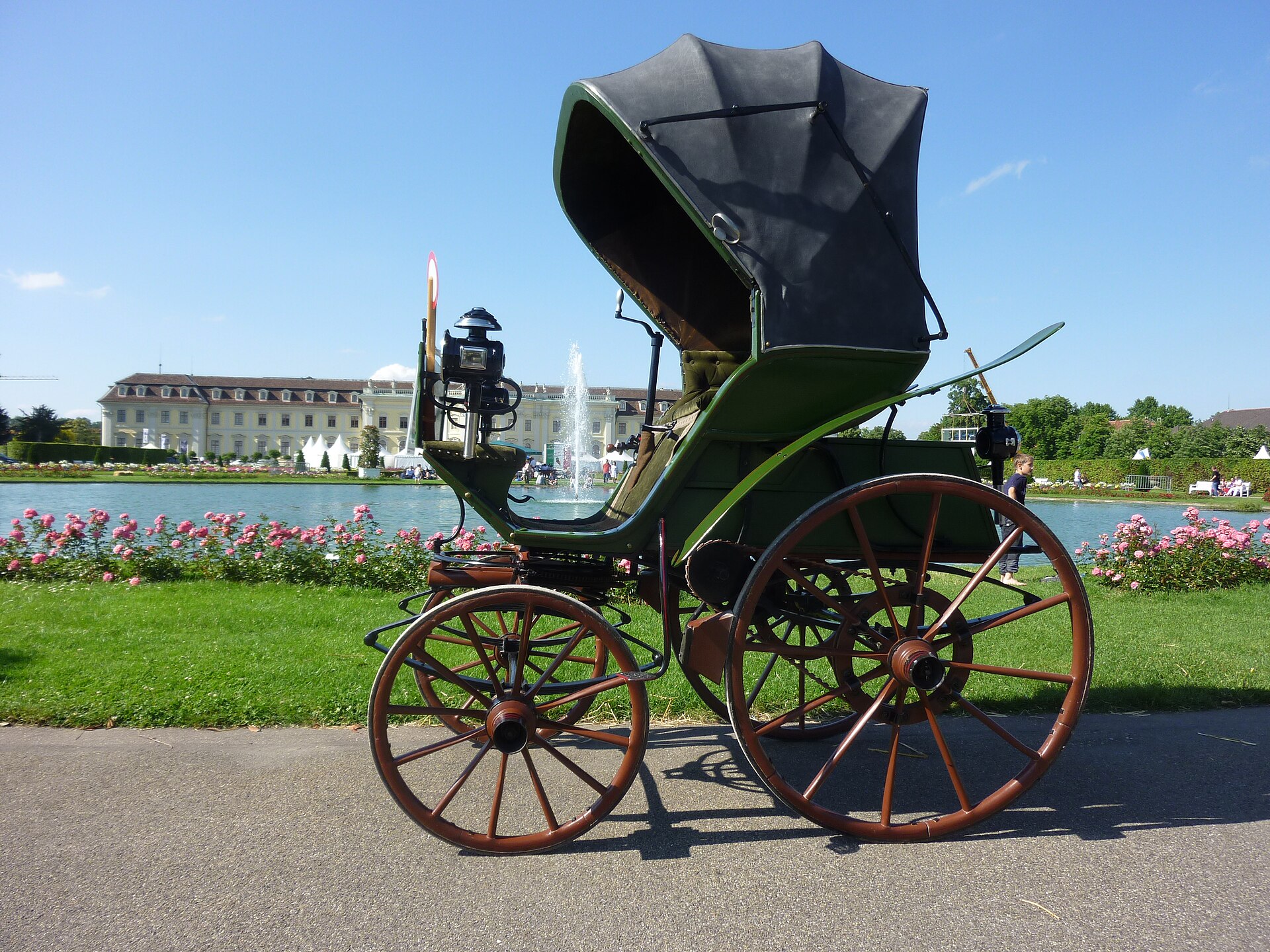 The Flocken Elektrowagen (1888) was the first four-wheeled electric car in the world[41] 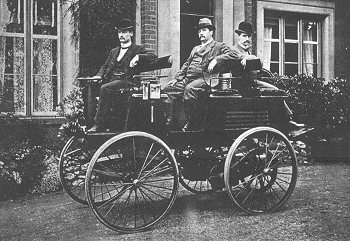 Early electric car built by Thomas Parker - photo from 1895[42]  "La Jamais Contente", 1899 [The Never Contented] 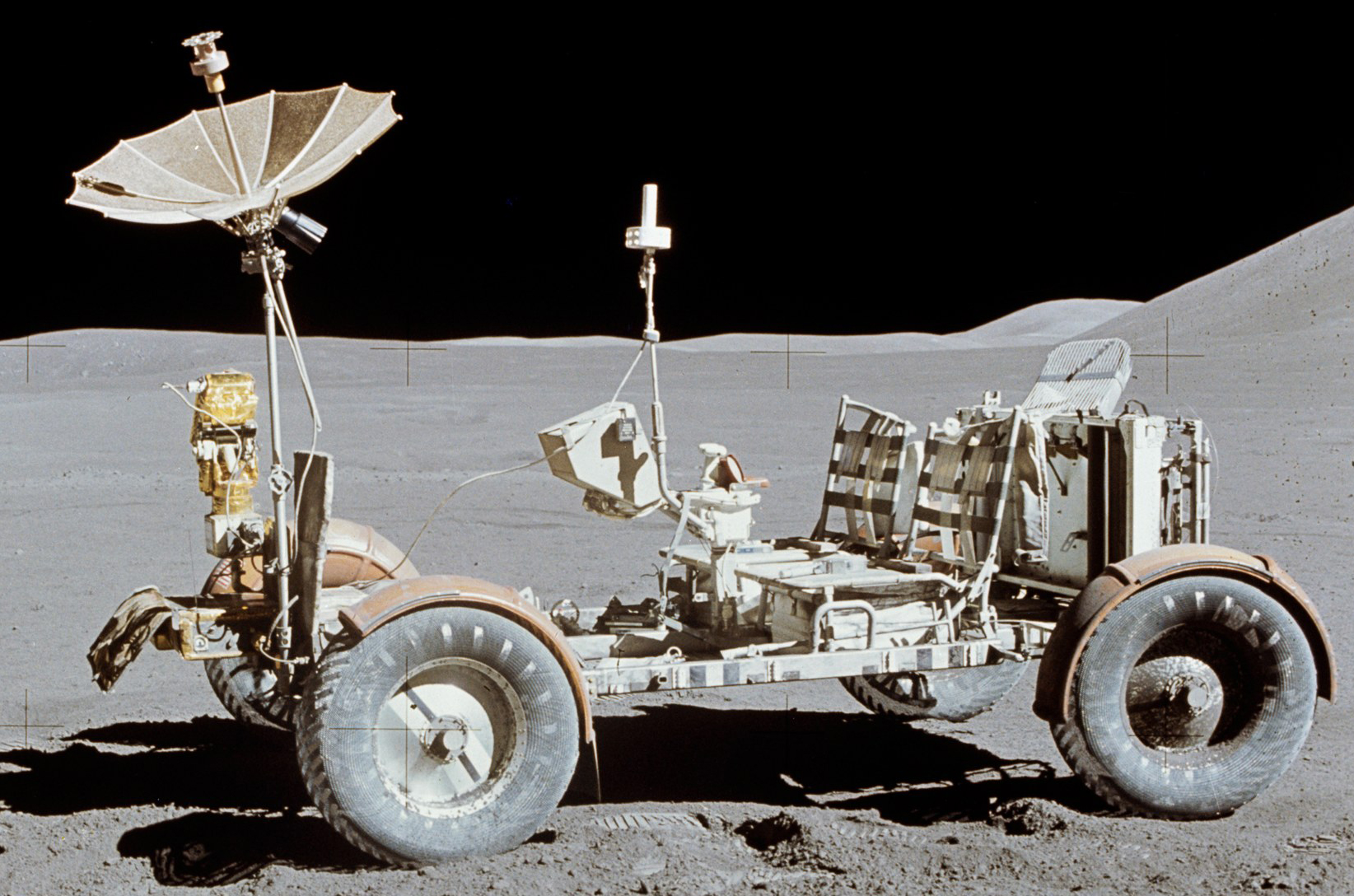 NASA's Lunar Roving Vehicles were battery-driven (1971) 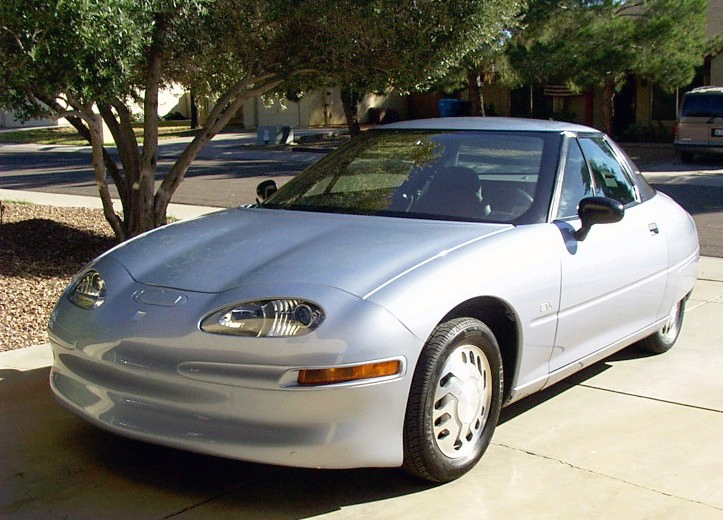 The General Motors EV1, one of the cars introduced due to a California Air Resources Board (CARB) mandate, had a range of 260 km (160 miles) with NiMH batteries in 1999. 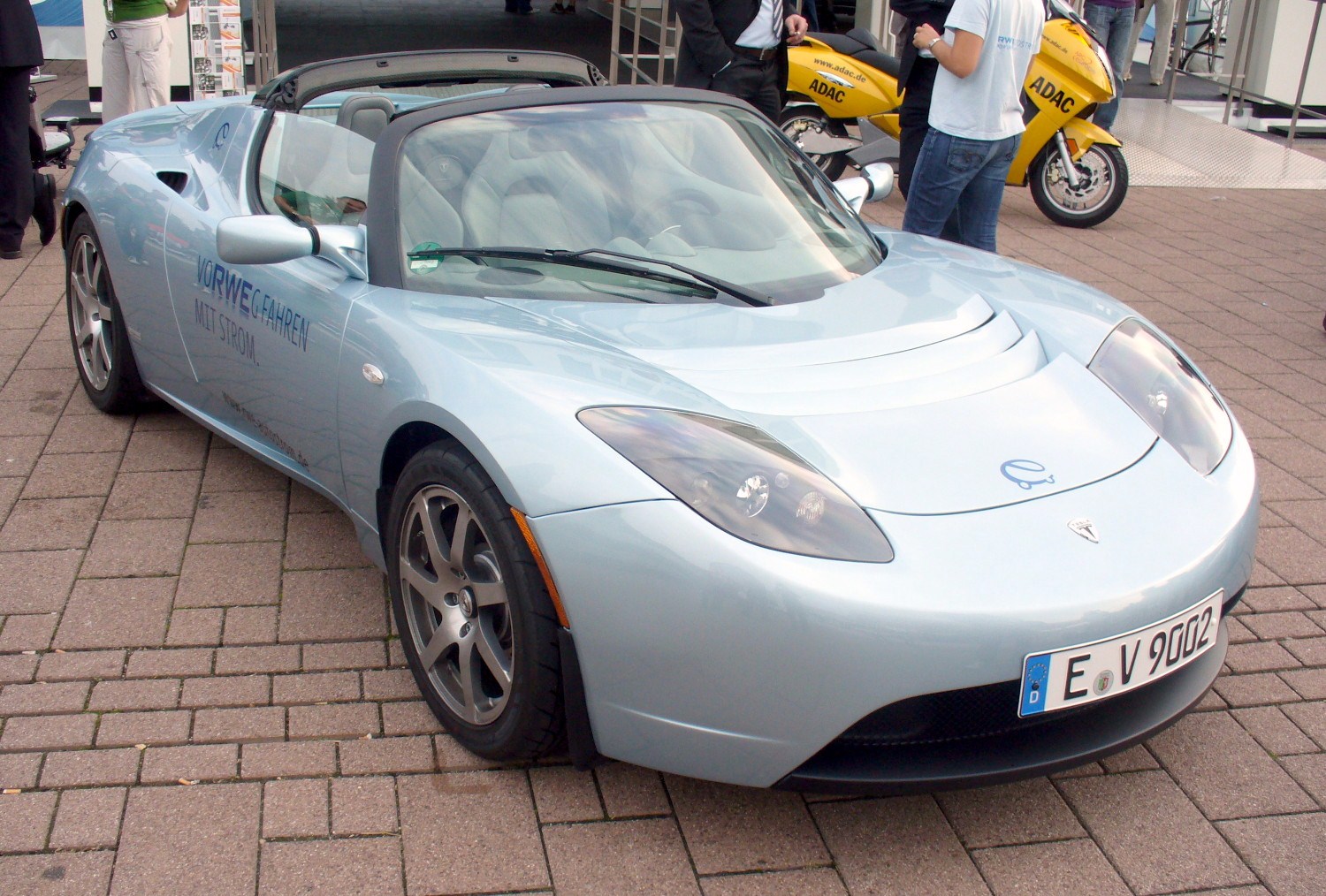 The Tesla Roadster (2008) helped inspire the modern generation of electric vehicles. |
 1937年 大阪市バスで運行を開始する中島式電気バス。天神橋筋六丁目から難波まで、往復約12キロで運用され、3往復走るとバッテリーを取り替えた。 |
| Modern electric cars In the early 1990s the California Air Resources Board (CARB) began a push for more fuel-efficient, lower-emissions vehicles, with the ultimate goal of a move to zero-emissions vehicles such as electric vehicles.[43][44] In response, automakers developed electric models. These early cars were eventually withdrawn from the U.S. market, because of a massive campaign by the US automakers to discredit the idea of electric cars.[45] California electric-automaker Tesla Motors began development in 2004 of what would become the Tesla Roadster, first delivered to customers in 2008. The Roadster was the first highway-legal all-electric car to use lithium-ion battery cells, and the first production all-electric car to travel more than 320 km (200 miles) per charge.[46] Better Place, a venture-backed company based in Palo Alto, California, but steered from Israel, developed and sold battery charging and battery swapping services for electric cars. The company was publicly launched on 29 October 2007 and announced deployment of electric vehicle networks in Israel, Denmark and Hawaii in 2008 and 2009. The company planned to deploy the infrastructure on a country-by-country basis. In January 2008, Better Place announced a memorandum of understanding with Renault-Nissan to build the world's first Electric Recharge Grid Operator (ERGO) model for Israel. Under the agreement, Better Place would build the electric recharge grid and Renault-Nissan would provide the electric vehicles. Better Place filed for bankruptcy in Israel in May 2013. The company's financial difficulties were caused by mismanagement, wasteful efforts to establish toeholds and run pilots in too many countries, the high investment required to develop the charging and swapping infrastructure, and a market penetration far lower than originally predicted.[47] 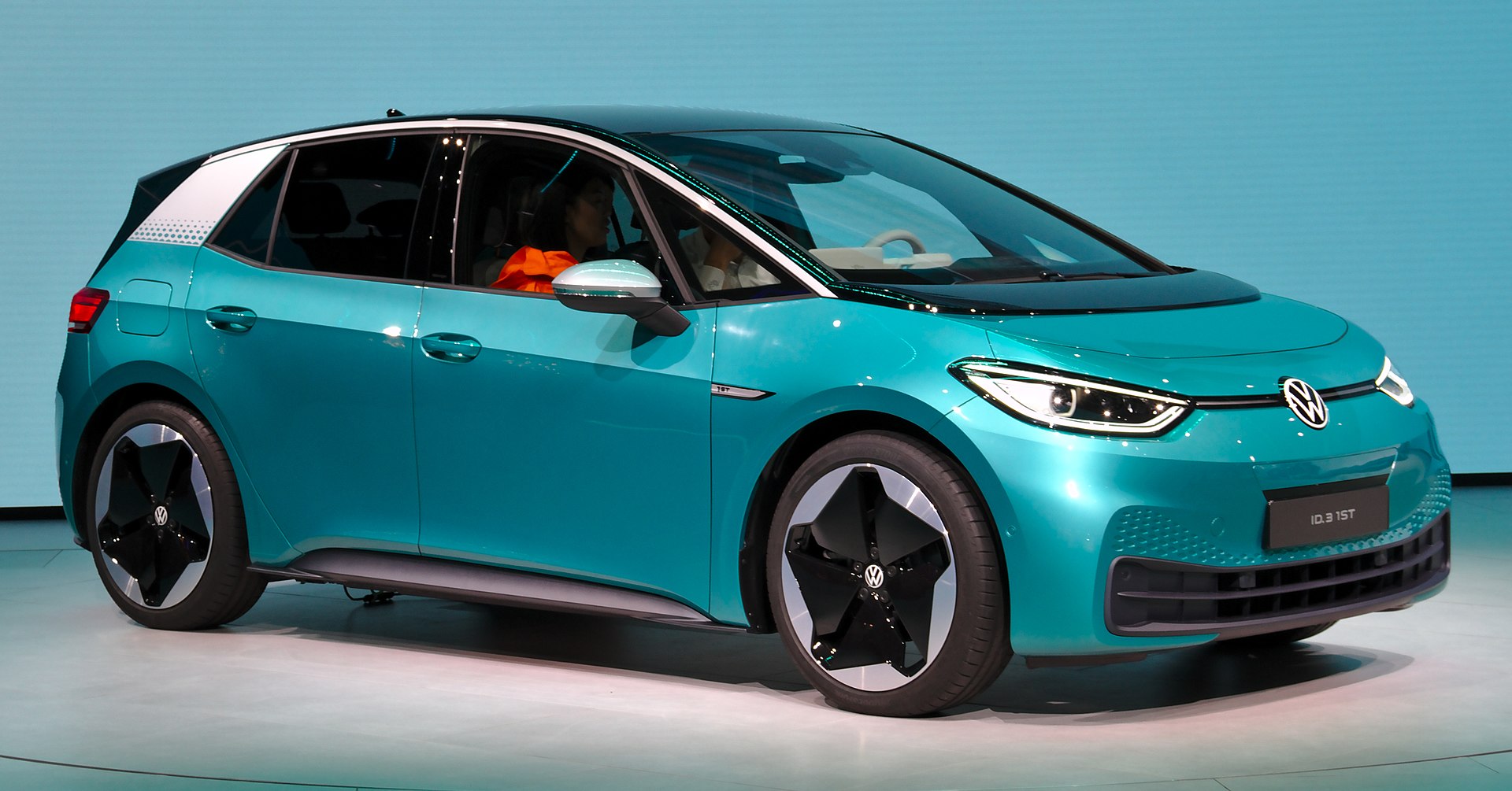 Volkswagen Group has invested in a wide-ranging electrification strategy in Europe, North America and China, with its electric "MEB" platform. The Mitsubishi i-MiEV, launched in 2009 in Japan, was the first highway-legal series production electric car,[48] and also the first all-electric car to sell more than 10,000 units. Several months later, the Nissan Leaf, launched in 2010, surpassed the i MiEV as the best selling all-electric car at that time.[49] Starting in 2008, a renaissance in electric vehicle manufacturing occurred due to advances in batteries, and the desire to reduce greenhouse-gas emissions and to improve urban air quality.[50] During the 2010s, the electric vehicle industry in China expanded rapidly with government support.[51] Several automakers marked up the prices of their electric vehicles in anticipation of the subsidy adjustments, including Tesla, Volkswagen and Guangzhou-based GAC Group, which counts Fiat, Honda, Isuzu, Mitsubishi, and Toyota as foreign partners.[52] In July 2019 US-based Motor Trend magazine awarded the fully-electric Tesla Model S the title "ultimate car of the year".[53] In March 2020 the Tesla Model 3 passed the Nissan Leaf to become the world's all-time best-selling electric car, with more than 500,000 units delivered;[19] it reached the milestone of 1 million global sales in June 2021.[20] 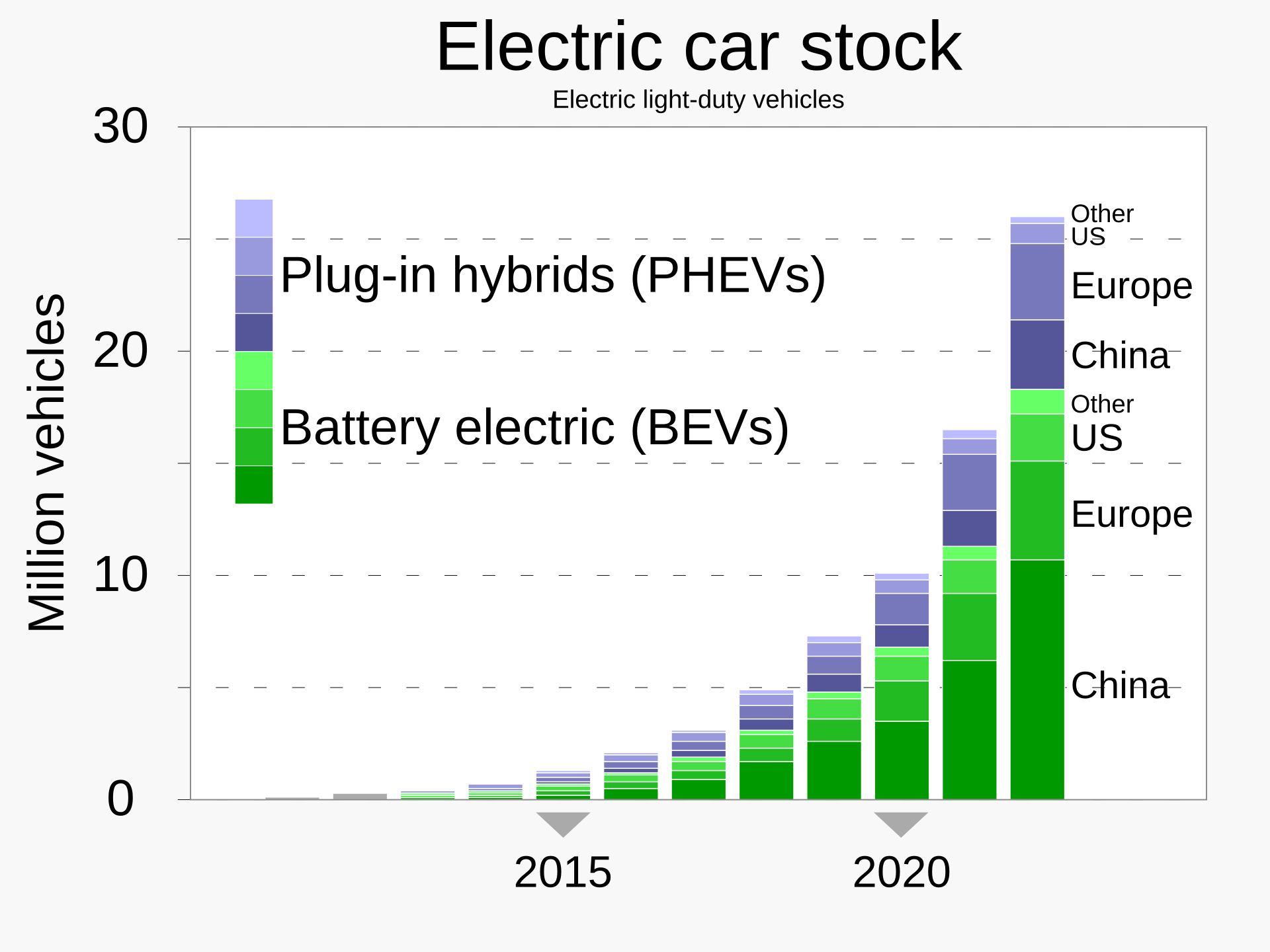 The global stock of both plug-in hybrid electric vehicles (PHEVs) and battery electric vehicles (BEVs) has grown steadily since the 2010s.[54] 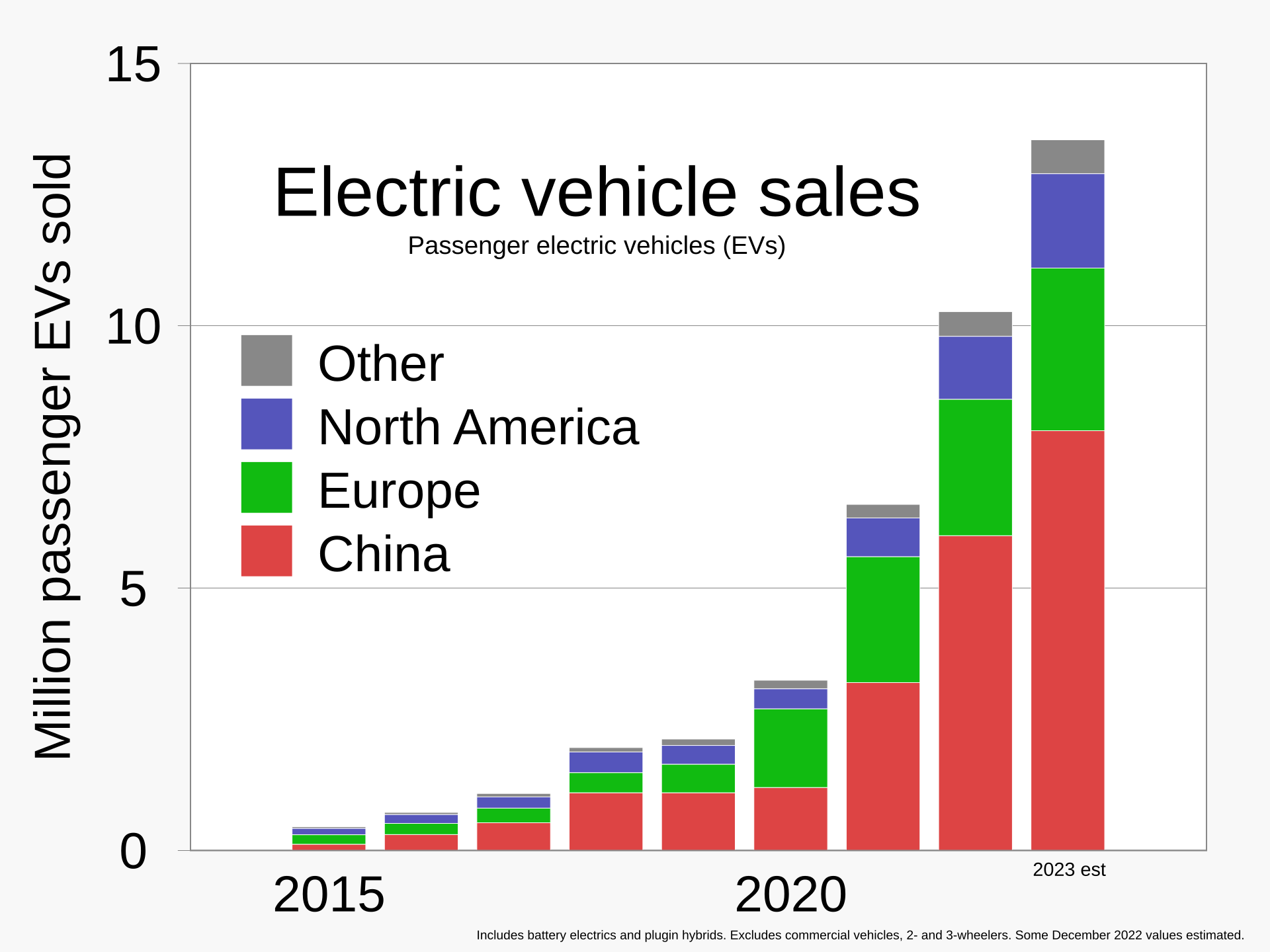 Sales of passenger electric vehicles (EVs) indicate a trend away from gas-powered vehicles.[55] In the third quarter of 2021, the Alliance for Automotive Innovation reported that sales of electric vehicles had reached six percent of all US light-duty automotive sales, the highest volume of EV sales ever recorded at 187,000 vehicles. This was an 11% sales increase, as opposed to a 1.3% increase in gasoline and diesel-powered units. The report indicated that California was the US leader in EV with nearly 40% of US purchases, followed by Florida – 6%, Texas – 5% and New York 4.4%.[56] Electric companies from the Middle East have been designing electric cars. Oman's Mays Motors have developed the Mays i E1 which is expected to begin production in 2023. Built from carbon fibre, it has a range of about 560 km (350 miles) and can accelerate from 0–130 km/h (0–80 mph) in about 4 secs.[57] In Turkey, the EV company Togg is starting production of its electric vehicles. Batteries will be created in a joint venture with the Chinese company Farasis Energy.[58] |
現代の電気自動車 1990年代初頭、カリフォルニア州大気資源委員会(CARB)は、より低燃費で低排出ガスの自動車を求め、最終的には電気自動車のようなゼロ・エミッ ション車への移行を目標とした活動を開始した[43][44]。これに応じて、自動車メーカーは電気自動車モデルを開発した。これらの初期の自動車は、米 国の自動車メーカーによる電気自動車のアイデアを信用させないための大規模なキャンペーンのため、最終的に米国市場から撤退した[45]。 カリフォルニアの電気自動車メーカー、テスラ・モーターズは2004年にテスラ・ロードスターとなる車の開発を開始し、2008年に初めて顧客に納車され た。ロードスターは、リチウムイオンバッテリーセルを使用した初の高速道路走行可能な全電気自動車であり、1回の充電で320km(200マイル)以上走 行する初の量産全電気自動車であった[46]。 ベンチャー企業のベタープレイスは、カリフォルニア州パロアルトに本社を置くが、イスラエルから出資を受けており、電気自動車のバッテリー充電とバッテ リー交換サービスを開発・販売している。同社は2007年10月29日に株式公開し、2008年と2009年にイスラエル、デンマーク、ハワイで電気自動 車ネットワークを展開すると発表した。同社は国ごとにインフラを展開する計画だった。2008年1月、ベタープレイスはルノー・日産との間で、イスラエル に世界初のElectric Recharge Grid Operator(ERGO)モデルを構築する覚書を締結したと発表した。この合意では、ベタープレイスが電気充電グリッドを建設し、ルノー・日産が電気 自動車を提供する。ベタープレイスは2013年5月にイスラエルで破産を申請した。同社の経営難の原因は、誤った経営管理、多くの国で足場を固めパイロッ ト事業を行うという無駄な努力、充電とスワッピングのインフラ整備に必要な高額の投資、当初の予測をはるかに下回る市場浸透率であった[47]。  フォルクスワーゲン・グループは、欧州、北米、中国において、電気自動車「MEB」プラットフォームによる広範な電動化戦略に投資してきた。 2009年に日本で発売された三菱i-MiEVは、初の高速道路走行可能な量産電気自動車であり[48]、1万台以上を販売した初の電気自動車でもある。 その数ヵ月後、2010年に発売された日産リーフがi MiEVを抜き、当時最も売れた電気自動車となった[49]。 2008年以降、バッテリーの進歩、温室効果ガスの排出削減と都市の大気環境の改善への要望により、電気自動車製造のルネッサンスが起こった[50]。 2010年代、中国の電気自動車産業は政府の支援を受けて急速に拡大した[51]。いくつかの自動車メーカーは、補助金の調整を見越して電気自動車の価格 を引き上げた。その中には、テスラ、フォルクスワーゲン、広州を拠点とするGACグループが含まれ、フィアット、ホンダ、いすゞ、三菱、トヨタを海外パー トナーとして数える[52]。 2019年7月、米国の『Motor Trend』誌は完全電気自動車のテスラ・モデルSに「究極のカー・オブ・ザ・イヤー」の称号を与えた[53]。 2020年3月、テスラ・モデル3は日産リーフを抜き、50万台以上を販売し、世界で最も売れた電気自動車となった[19]。2021年6月には世界販売 台数100万台のマイルストーンに到達した[20]。  プラグインハイブリッド電気自動車(PHEV)とバッテリー電気自動車(BEV)の世界的な在庫は、2010年代以降、着実に増加している[54]。  乗用電気自動車(EV)の販売は、ガスエンジン車からの脱却の傾向を示している[55]。 2021年第3四半期に、Alliance for Automotive Innovationは、電気自動車の販売台数が米国の小型自動車販売台数の6%に達し、EVの販売台数としては過去最高の187,000台に達したと報 告した。これは、ガソリン車とディーゼル車の1.3%増に対し、11%の販売増であった。報告書によると、カリフォルニア州がEV購入台数の40%近くを 占め、米国のEVリーダーであり、次いでフロリダ州の6%、テキサス州の5%、ニューヨーク州の4.4%であった[56]。 中東の電気自動車会社も電気自動車を設計している。オマーンのメイズ・モーターズはメイズi E1を開発し、2023年に生産を開始する予定である。カーボンファイバー製で、航続距離は約560km(350マイル)、時速0-130km(0-80 マイル)の加速は約4秒である[57]。トルコでは、EV企業のToggが電気自動車の生産を開始している。バッテリーは、中国のファラシス・エナジー社 との合弁事業で製造される[58]。 |
| Economics Manufacturing cost The most expensive part of an electric car is its battery. The price decreased from €605 per kWh in 2010, to €170 in 2017, to €100 in 2019.[59][60] When designing an electric vehicle, manufacturers may find that for low production, converting existing platforms may be cheaper, as development cost is lower; however, for higher production, a dedicated platform may be preferred to optimize design, and cost.[61] Total cost of ownership In the EU and US, but not yet China, the total cost of ownership of recent electric cars is cheaper than that of equivalent gasoline cars, due to lower fueling and maintenance costs.[16][17][62] A 2024 Consumer Reports analysis of 29 car brands found Tesla was the least expensive to maintain over a 10-year period; Tesla was the only all-electric brand included.[63] The greater the distance driven per year, the more likely the total cost of ownership for an electric car will be less than for an equivalent ICE car.[64] The break-even distance varies by country depending on the taxes, subsidies, and different costs of energy. In some countries the comparison may vary by city, as a type of car may have different charges to enter different cities; for example, in England, London charges ICE cars more than Birmingham does.[65] Purchase cost Several national and local governments have established EV incentives to reduce the purchase price of electric cars and other plug-ins.[66][67][68][69] As of 2020, the electric vehicle battery is more than a quarter of the total cost of the car.[70] Purchase prices are expected to drop below those of new ICE cars when battery costs fall below US$100 per kWh, which is forecast to be in the mid-2020s.[71][72] Leasing or subscriptions are popular in some countries,[73][74] depending somewhat on national taxes and subsidies,[75] and end of lease cars are expanding the second hand market.[76] In a June 2022 report by AlixPartners, the cost for raw materials on an average EV rose from $3,381 in March 2020 to $8,255 in May 2022. The cost increase voice is attributed mainly to lithium, nickel, and cobalt.[77] Running costs Electricity almost always costs less than gasoline per kilometer travelled, but the price of electricity often varies depending on where and what time of day the car is charged.[78][79] Cost savings are also affected by the price of gasoline which can vary by location.[80] |
エコノミクス 製造コスト 電気自動車で最も高価な部品はバッテリーである。価格は、2010年の1kWhあたり605ユーロから、2017年には170ユーロに、2019年には 100ユーロに低下している[59][60]。電気自動車を設計する際、メーカーは、生産台数が少ない場合は、既存のプラットフォームを転用した方が開発 コストが低いため安価になる可能性があることに気づくかもしれないが、生産台数が多い場合は、設計とコストを最適化するために、専用のプラットフォームが 好まれるかもしれない[61]。 総所有コスト EUと米国では、中国にはまだないが、最近の電気自動車の総所有コストは、燃料費と維持費が低いため、同等のガソリン車よりも安い[16][17] [62]。2024年のコンシューマー・レポートの29の自動車ブランドの分析によると、テスラが10年間の維持費が最も安く、テスラは唯一の全電気自動 車ブランドであった[63]。 年間走行距離が長ければ長いほど、電気自動車の総所有コストは同等のICE車よりも低くなる可能性が高くなる[64]。損益分岐距離は、税金、補助金、異 なるエネルギーコストによって国によって異なる。例えば、イギリスでは、ロンドンはバーミンガムよりもICE車の料金が高い[65]。 購入費用 いくつかの国民や地方自治体は、電気自動車やその他のプラグインの購入価格を引き下げるEVインセンティブを設けている[66][67][68] [69]。 2020年時点では、電気自動車のバッテリーは車の総コストの4分の1以上である[70]。バッテリーのコストが1kWhあたり100米ドルを下回ると、 購入価格は新車のICE車の価格を下回ると予想されており、それは2020年代半ばになると予測されている[71][72]。 一部の国ではリースやサブスクリプションが人気であり[73][74]、国民の税金や補助金にも多少左右されるが[75]、リース終了車は中古市場を拡大 している[76]。 アリックスパートナーズの2022年6月のレポートでは、平均的なEVの原材料費は2020年3月の3,381ドルから2022年5月には8,255ドル に上昇した。コスト上昇の主な要因は、リチウム、ニッケル、コバルトである[77]。 ランニングコスト 電気代は走行距離1キロメートルあたりでガソリン代より安いことがほとんどだが、電気代は充電する場所や時間帯によって異なることが多い[78] [79]。コスト削減は、場所によって異なるガソリンの価格にも影響される[80]。 |
Environmental aspects The Salar de Uyuni in Bolivia is one of the largest known lithium reserves in the world.[81][82] Main article: Environmental aspects of the electric car Electric cars have several benefits when replacing ICE cars, including a significant reduction of local air pollution, as they do not emit exhaust pollutants such as volatile organic compounds, hydrocarbons, carbon monoxide, ozone, lead, and various oxides of nitrogen.[83] Similar to ICE vehicles, electric cars emit particulates from tyre and brake wear[84] which may damage health,[85] although regenerative braking in electric cars means less brake dust.[86] More research is needed on non-exhaust particulates.[87] The sourcing of fossil fuels (oil well to gasoline tank) causes further damage as well as use of resources during the extraction and refinement processes. Depending on the production process and the source of the electricity to charge the vehicle, emissions may be partly shifted from cities to the plants that generate electricity and produce the car as well as to the transportation of material.[43] The amount of carbon dioxide emitted depends on the emissions of the electricity source and the efficiency of the vehicle. For electricity from the grid, the life-cycle emissions vary depending on the proportion of coal-fired power, but are always less than ICE cars.[88] The cost of installing charging infrastructure has been estimated to be repaid by health cost savings in less than three years.[89] According to a 2020 study, balancing lithium supply and demand for the rest of the century will require good recycling systems, vehicle-to-grid integration, and lower lithium intensity of transportation.[90] Some activists and journalists have raised concerns over the perceived lack of impact of electric cars in solving the climate change crisis[91] compared to other, less popularized methods.[92] These concerns have largely centered around the existence of less carbon-intensive and more efficient forms of transportation such as active mobility,[93] mass transit and e-scooters and the continuation of a system designed for cars first.[94] |
環境面 ボリビアのウユニ塩湖は、世界最大級のリチウム埋蔵量として知られている[81][82]。 主な記事 電気自動車の環境面 電気自動車は揮発性有機化合物、炭化水素、一酸化炭素、オゾン、鉛、様々な窒素酸化物などの排気汚染物質を排出しないため、地域の大気汚染を大幅に削減す ることができる。 [83]。ICE車と同様に、電気自動車はタイヤとブレーキの摩耗から微粒子を排出し[84]、保健に損害を与える可能性がある[85]が、電気自動車の 回生ブレーキはブレーキダストを少なくする[86]。排気以外の微粒子については、さらなる研究が必要である[87]。化石燃料の調達(油井からガソリン タンクまで)は、採掘と精製の過程で資源を使用するだけでなく、さらなる損害を引き起こす。 生産プロセスや自動車を充電する電力の供給源によっては、排出の一部が都市から発電や自動車を生産する工場や材料の輸送に移行する可能性がある[43]。 排出される二酸化炭素の量は、電力源の排出量と自動車の効率に依存する。送電網からの電力の場合、ライフサイクル排出量は石炭火力の割合によって異なる が、ICE車よりも常に少ない[88]。 2020年の調査によると、今世紀の残りのリチウム需給を均衡させるには、優れたリサイクル・システム、車両と送電網の統合、輸送におけるリチウム強度の 低下が必要となる[90]。 一部の活動家やジャーナリストは、気候変動の危機[91]を解決する上で、他のあまり普及していない方法と比較して、電気自動車がインパクトに欠けると認 識されていることについて懸念を表明している[92]。これらの懸念は主に、アクティブモビリティ、[93]大量輸送機関、eスクーターといった、より二 酸化炭素排出量が少なく、より効率的な交通形態の存在と、まず自動車のために設計されたシステムの継続に集中している[94]。 |
Public opinion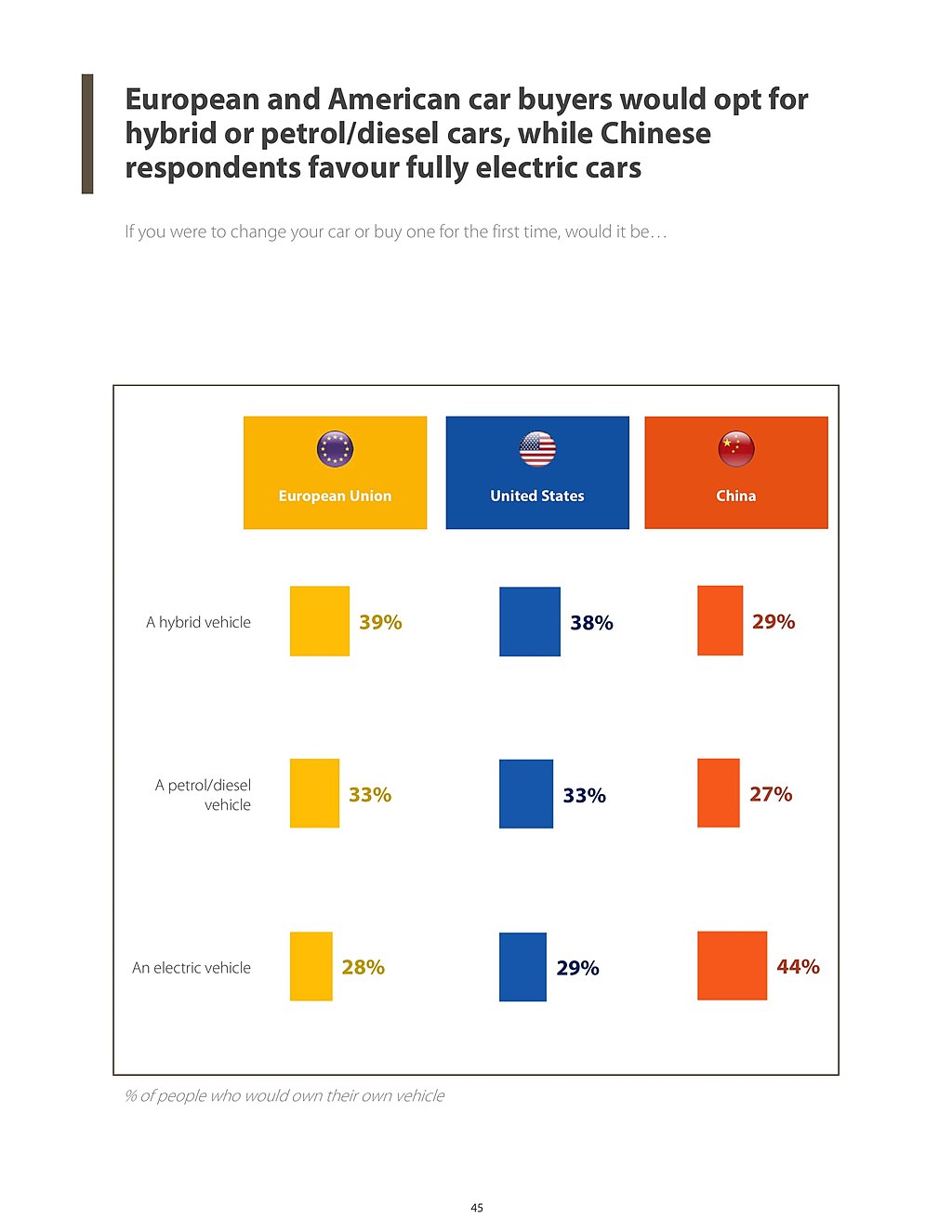 A 2022 climate survey highlighting European, American, and Chinese car buying preferences.[95] A 2022 survey found that 33% of car buyers in Europe will opt for a petrol or diesel car when purchasing a new vehicle. 67% of the respondents mentioned opting for the hybrid or electric version.[96][97] More specifically, it found that electric cars are only preferred by 28% of Europeans, making them the least preferred type of vehicle. 39% of Europeans tend to prefer hybrid vehicles, while 33% prefer petrol or diesel vehicles.[96][98] 44% Chinese car buyers, on the other hand, are the most likely to buy an electric car, while 38% of Americans would opt for a hybrid car, 33% would prefer petrol or diesel, while only 29% would go for an electric car.[96][99] Specifically for the EU, 47% of car buyers over 65 years old are likely to purchase a hybrid vehicle, while 31% of younger respondents do not consider hybrid vehicles a good option. 35% would rather opt for a petrol or diesel vehicle, and 24% for an electric car instead of a hybrid.[96][100] In the EU, only 13% of the total population do not plan on owning a vehicle at all.[96] |
世論調査 2022年の気候調査では、欧州、米国、中国の自動車購入の嗜好が浮き彫りになっている[95]。 2022年の調査では、欧州の自動車購入者の33%が新車購入時にガソリン車かディーゼル車を選ぶことがわかった。回答者の67%がハイブリッド車か電気 自動車を選ぶと述べている[96][97]。より具体的には、電気自動車はヨーロッパ人の28%にしか好まれず、最も好まれない車種であることがわかっ た。ヨーロッパ人の39%はハイブリッド車を好む傾向にあり、33%はガソリン車かディーゼル車を好む[96][98]。 一方、中国の自動車購入者の44%は電気自動車を購入する可能性が最も高いが、アメリカ人の38%はハイブリッド車を選び、33%はガソリン車かディーゼ ル車を好むが、電気自動車を選ぶのは29%に過ぎない[96][99]。 特にEUでは、65歳以上の自動車購入者の47%がハイブリッド車を購入する可能性があるが、若い回答者の31%はハイブリッド車を良い選択肢とは考えて いない。35%はガソリン車かディーゼル車を、24%はハイブリッド車ではなく電気自動車を選ぶと回答している[96][100]。 EUでは、自動車を所有するつもりのない人は全人口の13%に過ぎない[96]。 |
| Performance Acceleration and drivetrain design 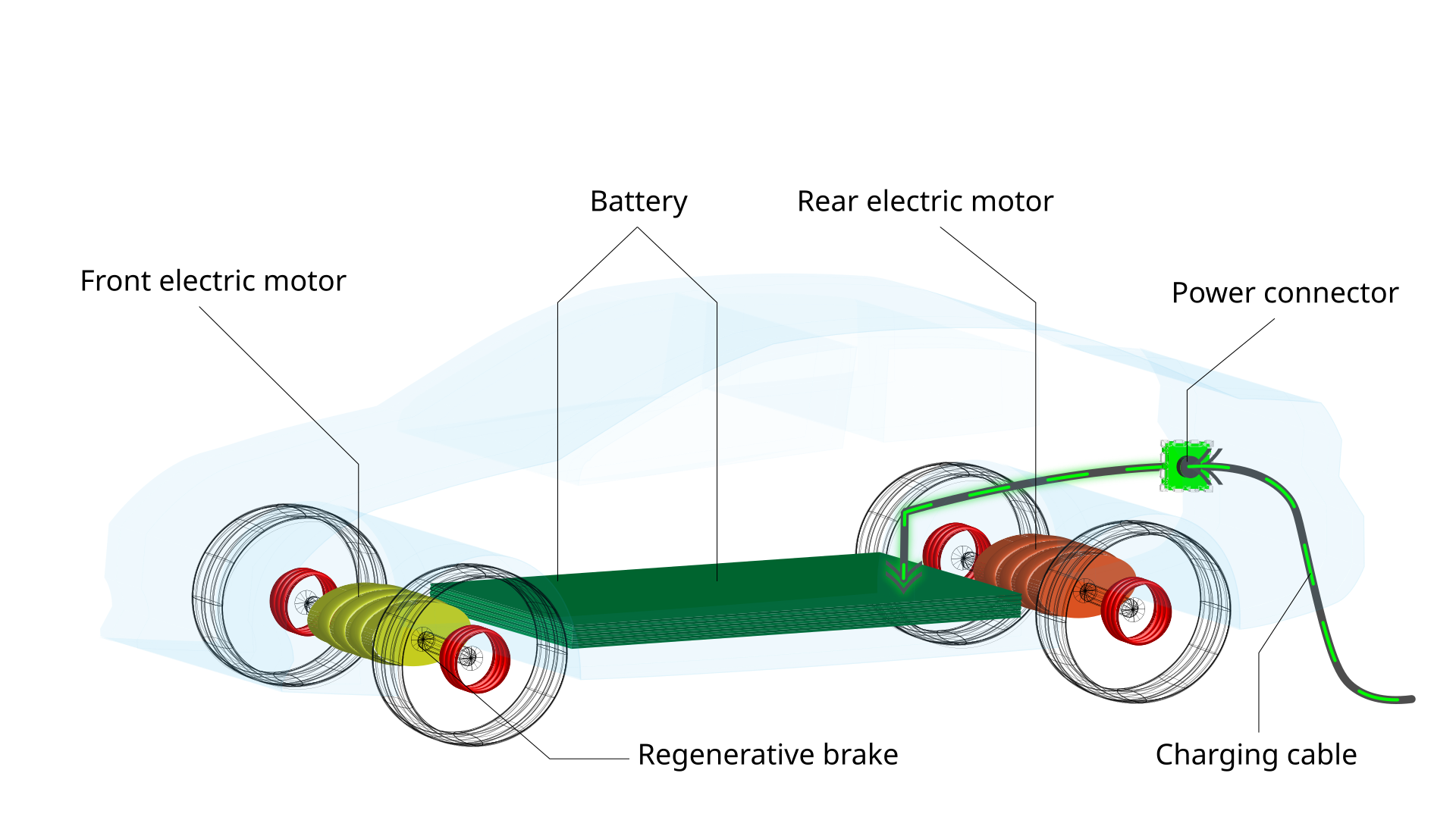 Typical "skateboard" layout with the battery as floor and a motor at one or both axles Electric motors can provide high power-to-weight ratios. Batteries can be designed to supply the electrical current needed to support these motors. Electric motors have a flat torque curve down to zero speed. For simplicity and reliability, most electric cars use fixed-ratio gearboxes and have no clutch. Many electric cars have faster acceleration than average ICE cars, largely due to reduced drivetrain frictional losses and the more quickly-available torque of an electric motor.[101] However, NEVs may have a low acceleration due to their relatively weak motors. Electric vehicles can also use a motor in each wheel hub or next to the wheels; this is rare but claimed to be safer.[102] Electric vehicles that lack an axle, differential, or transmission can have less drivetrain inertia. Some direct current motor-equipped drag racer EVs have simple two-speed manual transmissions to improve top speed.[103] The concept electric supercar Rimac Concept One claims it can go from 0–97 km/h (0–60 mph) in 2.5 seconds. Tesla claims the upcoming Tesla Roadster will go 0–60 mph (0–97 km/h) in 1.9 seconds.[104] |
パフォーマティビティ 加速性能とドライブトレイン設計  典型的な 「スケートボード 」レイアウトで、バッテリーがフロア、モーターが片方または両方の車軸にある。 電気モーターは高い出力対重量比を実現できる。バッテリーは、これらのモーターをサポートするために必要な電流を供給するように設計することができる。電 気モーターはゼロ速度まで平坦なトルク曲線を描く。シンプルさと信頼性のため、ほとんどの電気自動車は固定比ギアボックスを使用し、クラッチはない。 多くの電気自動車は、平均的なICE車よりも加速が速い。これは主に、ドライブトレインの摩擦損失が減少し、電気モーターのトルクがより迅速に利用できる ためである[101]。ただし、NEVはモーターが比較的弱いため、加速が低い場合がある。 アクスル、ディファレンシャル、トランスミッションを持たない電気自動車は、ドライブトレインのイナーシャを小さくすることができる[102]。直流モー ターを搭載したドラッグレーサーのEVの中には、最高速度を向上させるためにシンプルな2速マニュアルトランスミッションを搭載しているものもある [103]。コンセプト電気スーパーカーのリマック・コンセプト・ワンは、0-97km/h(0-60mph)を2.5秒で走れると主張している。テスラ は、次期テスラ・ロードスターの0-97 km/h加速を1.9秒としている[104]。 |
| Energy efficiency Main article: Electric car energy efficiency Energy efficiency of electric cars in towns and on motorways according to the DoE Internal combustion engines have thermodynamic limits on efficiency, expressed as a fraction of energy used to propel the vehicle compared to energy produced by burning fuel. Gasoline engines effectively use only 15% of the fuel energy content to move the vehicle or to power accessories; diesel engines can reach on-board efficiency of 20%; electric vehicles convert over 77% of the electrical energy from the grid to power at the wheels.[105][106][107] Electric motors are more efficient than internal combustion engines in converting stored energy into driving a vehicle. However, they are not equally efficient at all speeds. To allow for this, some cars with dual electric motors have one electric motor with a gear optimised for city speeds and the second electric motor with a gear optimised for highway speeds. The electronics select the motor that has the best efficiency for the current speed and acceleration.[108] Regenerative braking, which is most common in electric vehicles, can recover as much as one fifth of the energy normally lost during braking.[43][106] |
エネルギー効率 主な記事 電気自動車のエネルギー効率 DoEによる、市街地と高速道路での電気自動車のエネルギー効率 内燃機関の効率には熱力学的な限界があり、燃料の燃焼によって生成されるエネルギーと比較して、車両を推進するために使用されるエネルギーの割合で表され る。ガソリン・エンジンは、燃料エネルギーの15%しか車両を動かしたり、アクセサリーに電力を供給したりしない。ディーゼル・エンジンは、車載効率 20%に達することができる。 電気モーターは、蓄積されたエネルギーを車両の駆動に変換することにおいて、内燃機関よりも効率的である。しかし、どの速度でも同じように効率的というわ けではない。このため、デュアル電気モーターを搭載した一部の車では、1つの電気モーターは市街地走行に最適なギアを備え、2つ目の電気モーターは高速道 路走行に最適なギアを備えている。電気自動車で最も一般的な回生ブレーキは、通常ブレーキ時に失われるエネルギーの5分の1を回収することができる [43][106]。 |
| Cabin heating and cooling Combustion powered cars harness waste heat from the engine to provide cabin heating, but this option is not available in an electric vehicle. While heating can be provided with an electric resistance heater, higher efficiency and integral cooling can be obtained with a reversible heat pump, such as on the Nissan Leaf.[109] PTC junction cooling[110] is also attractive for its simplicity—this kind of system is used, for example, in the 2008 Tesla Roadster. To avoid using part of the battery's energy for heating and thus reducing the range, some models allow the cabin to be heated while the car is plugged in. For example, the Nissan Leaf, the Mitsubishi i-MiEV, Renault Zoe and Tesla cars can be preheated while the vehicle is plugged in.[111][112][113] Some electric cars (for example, the Citroën Berlingo Electrique) use an auxiliary heating system (for example gasoline-fueled units manufactured by Webasto or Eberspächer) but sacrifice "green" and "Zero emissions" credentials. Cabin cooling can be augmented with solar power external batteries and USB fans or coolers, or by automatically allowing outside air to flow through the car when parked; two models of the 2010 Toyota Prius include this feature as an option.[114] |
キャビンの暖房と冷房 燃焼エンジン車は、エンジンからの廃熱を利用してキャビンを暖房するが、電気自動車ではこのオプションは利用できない。暖房は電気抵抗ヒーターで行うこと ができるが、日産リーフに搭載されているような可逆式ヒートポンプを使用すれば、より高効率で一体型の冷却を行うことができる[109]。PTCジャンク ション冷却[110]も、その簡便さから魅力的であり、この種のシステムは、例えば2008年のテスラ・ロードスターに採用されている。 バッテリーのエネルギーの一部を暖房に使って航続距離が短くなるのを避けるため、一部のモデルでは、クルマがプラグインされている間、キャビンを暖房でき るようにしている。例えば、日産リーフ、三菱i-MiEV、ルノーゾエ、テスラ車は、プラグイン中に予熱することができる[111][112] [113]。 一部の電気自動車(例えば、シトロエン・ベルリンゴ・エレクトリック)は、補助暖房システム(例えば、ベバスト社やエバースペーハー社製のガソリン燃料ユ ニット)を使用しているが、「グリーン」と「ゼロ・エミッション」の信用を犠牲にしている。キャビンの冷却は、太陽光発電の外部バッテリーとUSBファン やクーラーで補強することも、駐車時に自動的に外気を車内に取り入れることもできる。 |
Safety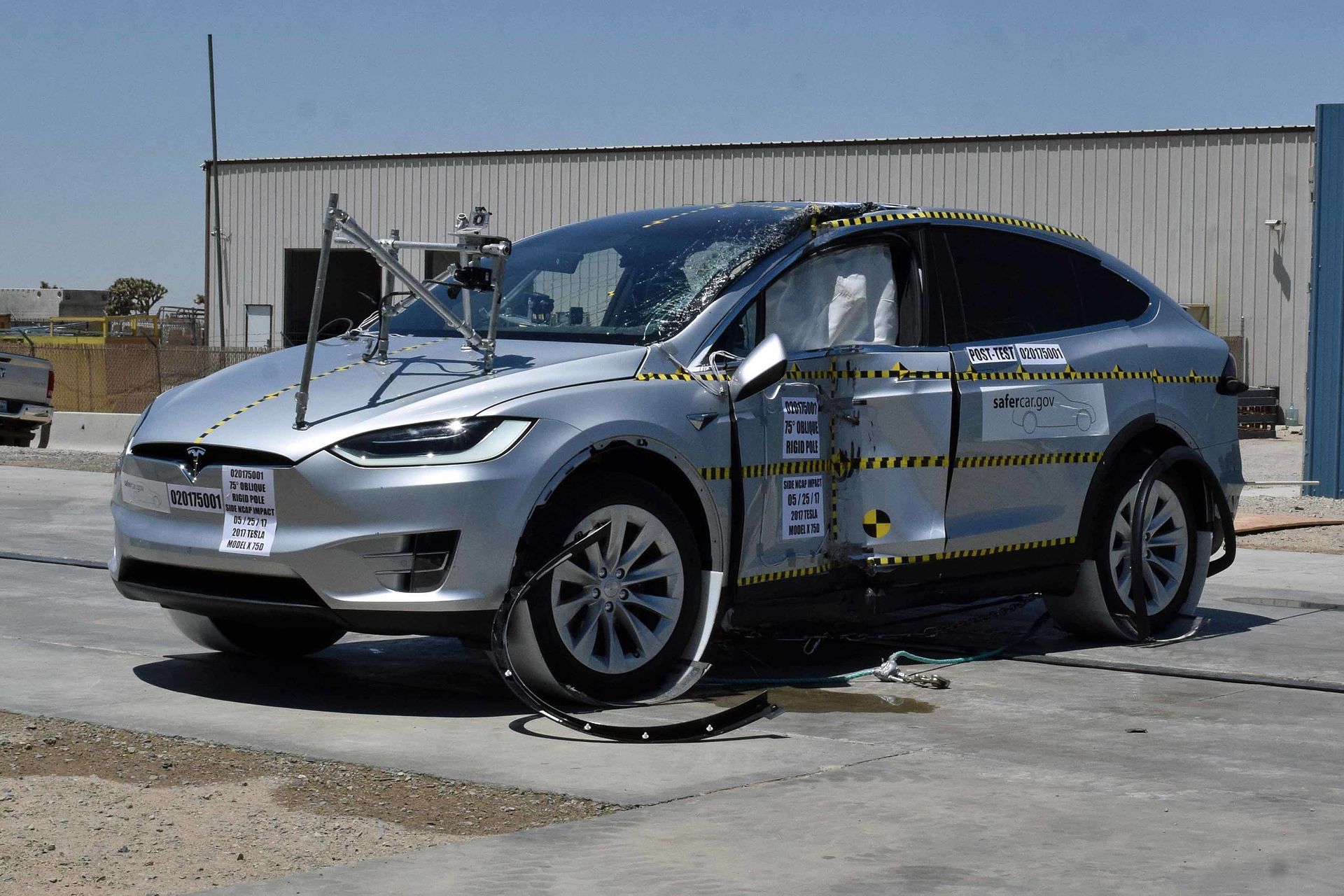 Side impact test of a Tesla Model X The safety issues of BEVs are largely dealt with by the international standard ISO 6469. This document is divided into three parts dealing with specific issues: On-board electrical energy storage, i.e. the battery[115] Functional safety means and protection against failures[116] Protection of persons against electrical hazards[117] Research published in the British Medical Journal in 2024 indicates that between 2013 and 2017 in the United Kingdom, electric cars killed pedestrians at twice the rate of petrol or diesel vehicles because "they are less audible to pedestrians in urban areas".[118] Jurisdictions have passed laws requiring electric vehicles to be manufactured with sound generators.[118] Weight The weight of the batteries themselves usually makes an EV heavier than a comparable gasoline vehicle. In a collision, the occupants of a heavy vehicle will, on average, suffer fewer and less serious injuries than the occupants of a lighter vehicle; therefore, the additional weight brings safety benefits to the occupant, while increasing harm to others.[119] On average, an accident will cause about 50% more injuries to the occupants of a 2,000 lb (900 kg) vehicle than those in a 3,000 lb (1,400 kg) vehicle.[120] Heavier cars are more dangerous to people outside the car if they hit a pedestrian or another vehicle.[121] Stability The battery in skateboard configuration lowers the center of gravity, increasing driving stability, lowering the risk of an accident through loss of control.[122] Additionally, a lower center of gravity provides a greater resistance to roll-over crashes.[123] If there is a separate motor near or in each wheel, this is claimed to be safer due to better handling.[124] Risk of fire Main article: Plug-in electric vehicle fire incidents Like their ICE counterparts, electric vehicle batteries can catch fire after a crash or mechanical failure.[125] Plug-in electric vehicle fire incidents have occurred, albeit fewer per distance traveled than ICE vehicles.[126] Some cars' high-voltage systems are designed to shut down automatically in the event of an airbag deployment,[127][128] and in case of failure firefighters may be trained for manual high-voltage system shutdown.[129][130] Much more water may be required than for ICE car fires and a thermal imaging camera is recommended to warn of possible re-ignition of battery fires.[131][132] |
安全性 テスラ・モデルXの側面衝突試験 BEVの安全問題は、国際規格ISO 6469で主に扱われている。この文書は、特定の問題を扱う3つの部分に分かれている: 車載電気エネルギー貯蔵、すなわちバッテリー[115]。 機能安全手段と故障に対する保護[116]。 電気的危険に対する人間の保護[117]。 2024年にBritish Medical Journalに掲載された調査によると、イギリスでは2013年から2017年の間に、電気自動車はガソリン車やディーゼル車の2倍の割合で歩行者を死 亡させている。 重量 バッテリー自体の重量により、通常、EVは同等のガソリン車よりも重くなる。衝突事故では、重い車の乗員は、平均して、軽い車の乗員よりも怪我が少なく、 重傷にならない。したがって、重量が増すと、乗員には安全上の利点がもたらされるが、他の乗員にとっては害が増すことになる[119]。平均して、事故で は、2,000ポンド(900kg)の車の乗員は、3,000ポンド(1,400kg)の車の乗員よりも怪我が約50%多くなる[120]。重い車は、歩 行者や他の車に衝突した場合、車外の人にとってより危険である[121]。 安定性 スケートボードの形状のバッテリーは重心を下げ、走行安定性を高め、制御不能による事故のリスクを下げる[122]。さらに、重心が低いと横転事故に対す る抵抗が大きくなる[123]。各ホイールの近くまたはホイールの中に独立したモーターがある場合、ハンドリングが良くなるためより安全だと主張されてい る[124]。 火災のリスク 主な記事 プラグイン電気自動車の火災事故 ICE車と同様に、電気自動車のバッテリーは衝突や機械的故障の後に発火する可能性がある[125]。プラグイン電気自動車の発火事故は、ICE車よりも 走行距離あたりの発生件数は少ないものの、発生している[126]。 [126]。一部の車の高電圧システムは、エアバッグが展開した場合に自動的にシャットダウンするように設計されており[127][128]、故障の場合 には消防士が手動で高電圧システムをシャットダウンする訓練を受ける場合がある[129][130]。ICE車の火災よりもはるかに多くの水が必要となる 場合があり、バッテリー火災の再発火の可能性を警告するために赤外線カメラの使用が推奨されている[131][132]。 |
| Controls As of 2018, most electric cars have similar driving controls to that of a car with a conventional automatic transmission. Even though the motor may be permanently connected to the wheels through a fixed-ratio gear, and no parking pawl may be present, the modes "P" and "N" are often still provided on the selector. In this case, the motor is disabled in "N" and an electrically actuated hand brake provides the "P" mode. In some cars, the motor will spin slowly to provide a small amount of creep in "D", similar to a traditional automatic transmission car.[133] When an internal combustion vehicle's accelerator is released, it may slow by engine braking, depending on the type of transmission and mode. EVs are usually equipped with regenerative braking that slows the vehicle and recharges the battery somewhat.[134] Regenerative braking systems also decrease the use of the conventional brakes (similar to engine braking in an ICE vehicle), reducing brake wear and maintenance costs. |
コントロール(制御) 2018年現在、ほとんどの電気自動車は、従来のオートマチック・トランスミッション搭載車と同様の運転制御を備えている。モーターが固定比ギアを介して 車輪に常時接続され、パーキング爪がない場合でも、セレクターに「P」と「N」のモードが設けられていることが多い。この場合、「N 」ではモーターは作動せず、電動ハンドブレーキが 「P 」モードを提供する。 一部の車では、従来のオートマチック・トランスミッション車と同様に、「D」ではモーターがゆっくりと回転し、わずかなクリープを提供する[133]。 内燃自動車のアクセルを離すと、トランスミッションの種類やモードによっては、エンジンブレーキによって減速することがある。EVは通常、車両を減速さ せ、バッテリーをいくらか充電する回生ブレーキを装備している[134]。回生ブレーキ・システムはまた、従来のブレーキ(ICE車のエンジン・ブレーキ と同様)の使用を減らし、ブレーキの摩耗とメンテナンス・コストを削減する。 |
Batteries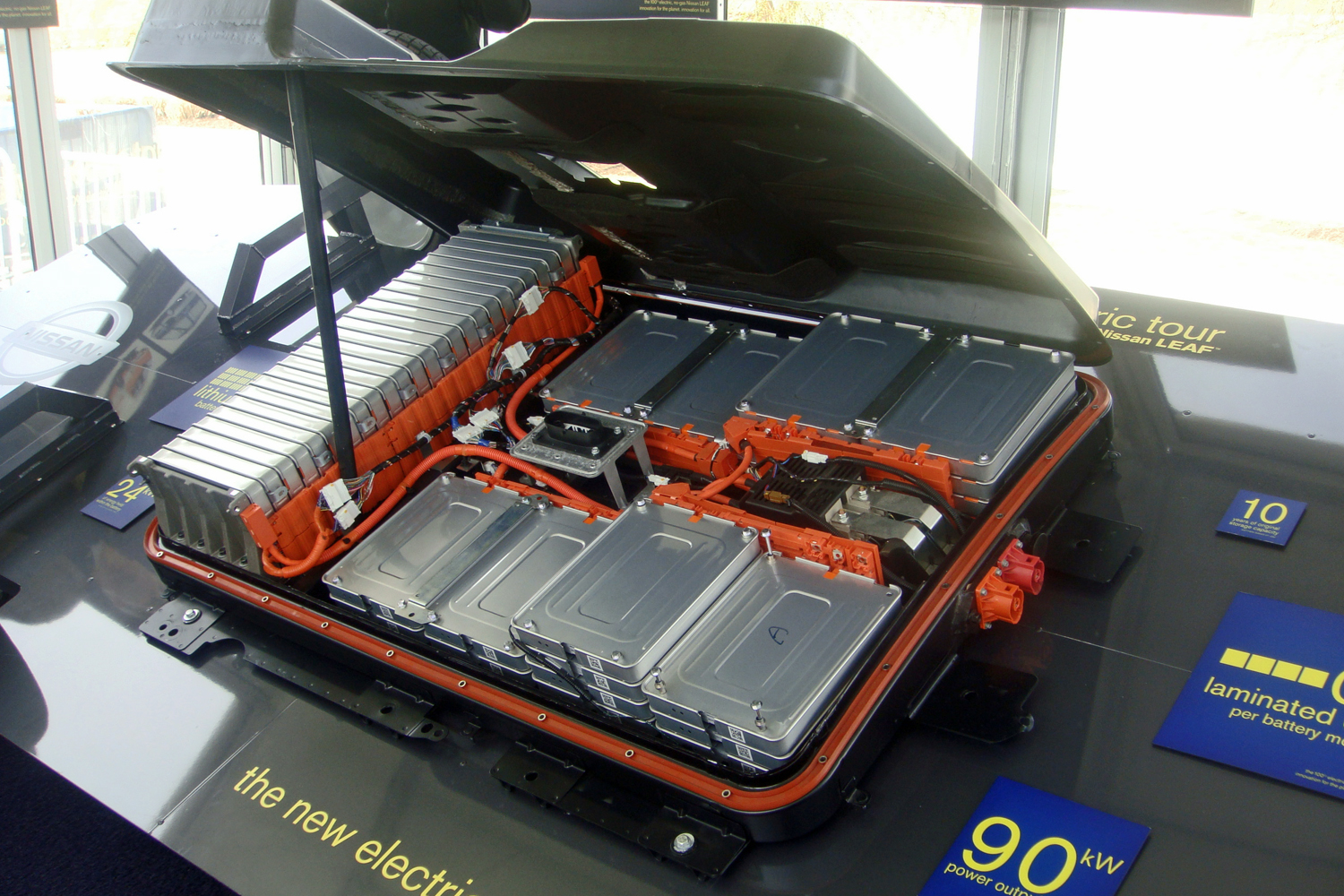 Nissan Leaf battery pack Main article: Electric vehicle battery Lithium-ion-based batteries are often used for their high power and energy density.[135] Batteries with different chemical compositions are becoming more widely used, such as lithium iron phosphate which is not dependent on nickel and cobalt so can be used to make cheaper batteries and thus cheaper cars.[136] Range Further information: List of electric cars currently available 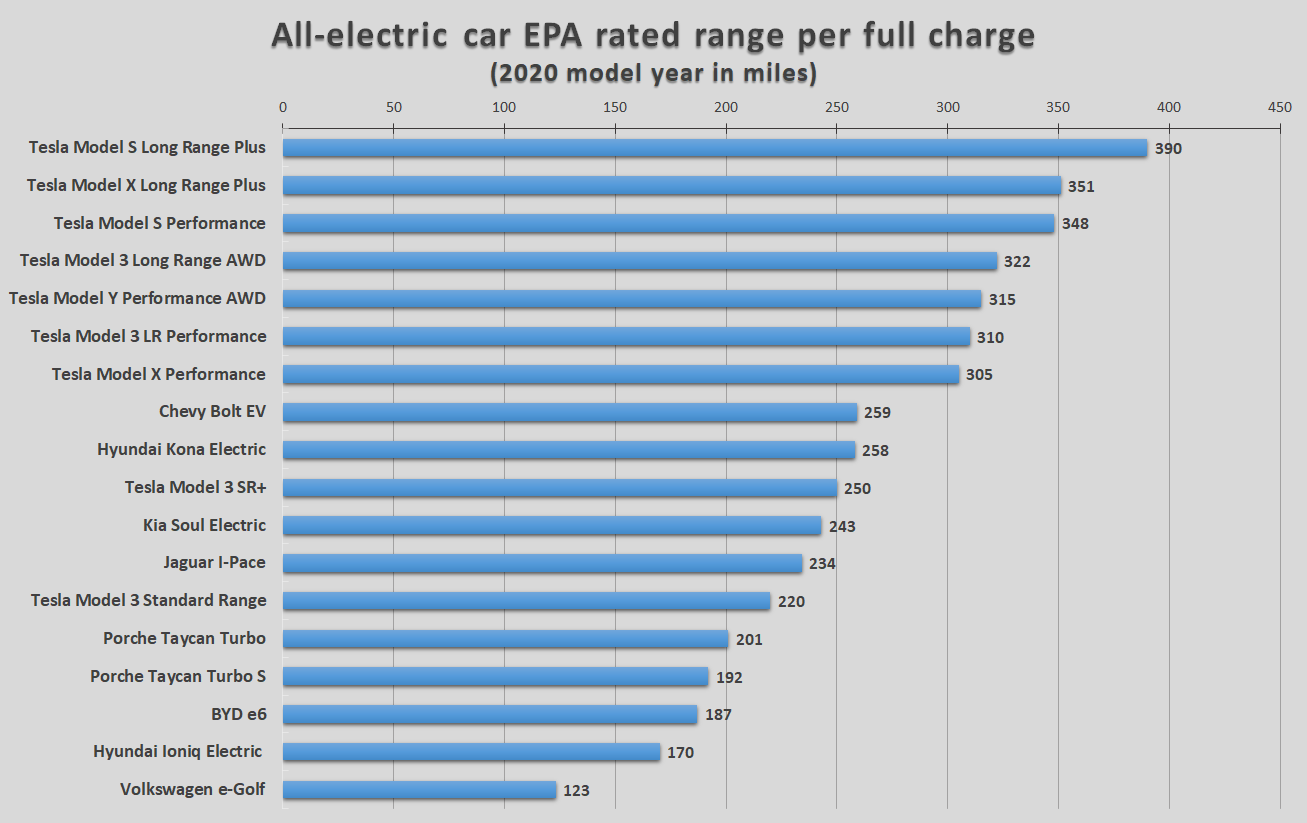 Comparison of EPA-rated range for model year 2020 electric cars rated up until January 2020. Comparison of EPA-rated range for model year 2020 electric cars rated up until January 2020[137] The range of an electric car depends on the number and type of batteries used, and (as with all vehicles), the aerodynamics, weight and type of vehicle, performance requirements, and the weather.[138] Cars marketed for mainly city use are often manufactured with a short range battery to keep them small and light.[139] Most electric cars are fitted with a display of the expected range. This may take into account how the vehicle is being used and what the battery is powering. However, since factors can vary over the route, the estimate can vary from the actual range. The display allows the driver to make informed choices about driving speed and whether to stop at a charging point en route. Some roadside assistance organizations offer charge trucks to recharge electric cars in case of emergency.[140] |
バッテリー 日産リーフのバッテリーパック 主な記事 電気自動車のバッテリー リン酸鉄リチウムはニッケルやコバルトに依存しないため、より安価な電池を作ることができ、その結果、より安価な自動車を作ることができる[136]。 航続距離 さらなる情報: 現在販売されている電気自動車のリスト  2020年モデルの電気自動車のEPA評価航続距離の比較(2020年1月まで)。 2020年1月までの2020年モデルの電気自動車のEPA評価航続距離の比較[137]。 電気自動車の航続距離は、使用されるバッテリーの数と種類、および(すべての自動車と同様に)空気力学、重量と車両の種類、必要な性能、天候に依存する [138]。主に市街地での使用を目的として販売される自動車は、小型・軽量に保つために航続距離の短いバッテリーを搭載して製造されることが多い [139]。 ほとんどの電気自動車には、予想航続距離の表示が取り付けられている。これは、車両の使用状況やバッテリーの電力を考慮したものである。しかし、走行ルー トによって要因は異なるため、予想航続距離は実際の航続距離とは異なる可能性がある。この表示によって、ドライバーは走行速度や途中で充電ポイントに立ち 寄るべきかどうかなど、十分な情報を得た上で選択することができる。緊急時に電気自動車を充電するための充電車を提供するロードサイドアシスタンス組織も ある[140]。 |
| Charging Connectors Main article: IEC 62196 Most electric cars use a wired connection to supply electricity for recharging. Electric vehicle charging plugs are not universal throughout the world. However vehicles using one type of plug are generally able to charge at other types of charging stations through the use of plug adapters.[141] The Type 2 connector is the most common type of plug, but different versions are used in China and Europe.[142][143] The Type 1 (also called SAE J1772) connector is common in North America[144][145] but rare elsewhere, as it does not support three-phase charging.[146] Wireless charging, either for stationary cars or as an electric road,[147] is less common as of 2021, but is used in some cities for taxis.[148][149] Home charging Electric cars are usually charged overnight from a home charging station; sometimes known as a charging point, wallbox charger, or simply a charger; in a garage or on the outside of a house.[150][151] As of 2021 typical home chargers are 7 kW, but not all include smart charging.[150] Compared to fossil fuel vehicles, the need for charging using public infrastructure is diminished because of the opportunities for home charging; vehicles can be plugged in and begin each day with a full charge.[152] Charging from a standard outlet is also possible but very slow. Public charging 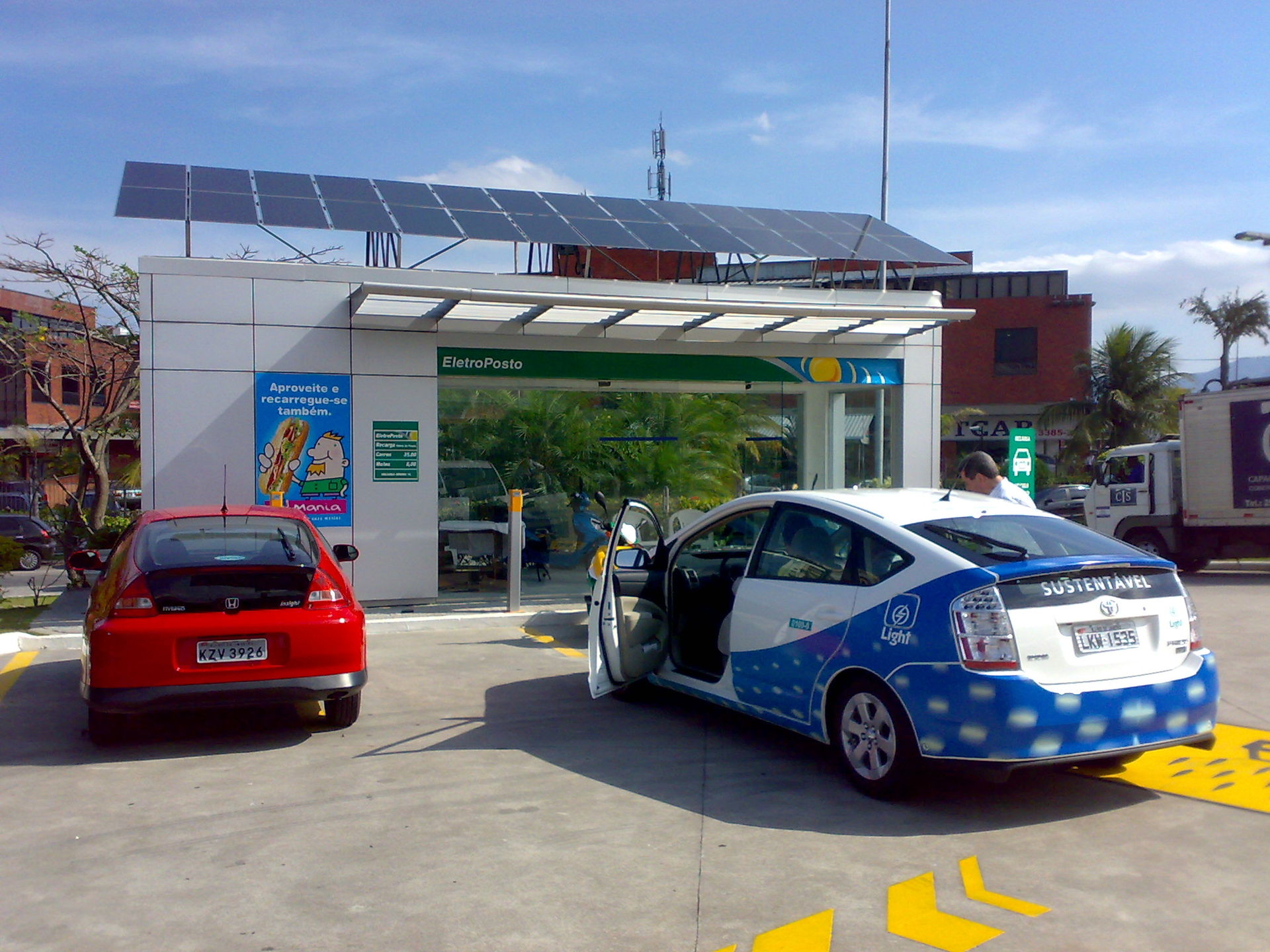 Charging station at Rio de Janeiro, Brazil. This station is run by Petrobras and uses solar energy. Main article: Electric vehicle charging network Public charging stations are almost always faster than home chargers,[153] with many supplying direct current to avoid the bottleneck of going through the car's AC to DC converter,[154] as of 2021 the fastest being 350 kW.[155] Combined Charging System (CCS) is the most widespread charging standard,[143] whereas the GB/T 27930 standard is used in China, and CHAdeMO in Japan. The United States has no de facto standard, with a mix of CCS, Tesla Superchargers, and CHAdeMO charging stations. Charging an electric vehicle using public charging stations takes longer than refueling a fossil fuel vehicle. The speed at which a vehicle can recharge depends on the charging station's charging speed and the vehicle's own capacity to receive a charge. As of 2021 some cars are 400-volt and some 800-volt.[156] Connecting a vehicle that can accommodate very fast charging to a charging station with a very high rate of charge can refill the vehicle's battery to 80% in 15 minutes.[157] Vehicles and charging stations with slower charging speeds may take as long as two hours to refill a battery to 80%. As with a mobile phone, the final 20% takes longer because the systems slow down to fill the battery safely and avoid damaging it. A battery swapping station operated by Nio Some companies are building battery swapping stations, to substantially reduce the effective time to recharge.[158][159] Some electric cars (for example, the BMW i3) have an optional gasoline range extender. The system is intended as an emergency backup to extend range to the next recharging location, and not for long-distance travel.[160] |
充電 コネクター 主な記事 IEC 62196 ほとんどの電気自動車は、充電用の電気を供給するために有線接続を使用している。電気自動車の充電プラグは世界共通ではない。しかし、あるタイプのプラグ を使用している車両は、一般的にプラグアダプターを使用することで、他のタイプの充電ステーションで充電することができる[141]。 タイプ2のコネクタが最も一般的なタイプのプラグであるが、中国とヨーロッパでは異なるバージョンが使用されている[142][143]。 タイプ1(SAE J1772とも呼ばれる)コネクタは、北米では一般的であるが[144][145]、三相充電をサポートしていないため、他の地域ではまれである [146]。 ワイヤレス充電は、定置型自動車用、あるいは電気道路用として[147]、2021年時点ではあまり一般的ではないが、一部の都市ではタクシーに使用され ている[148][149]。 家庭での充電 電気自動車は通常、家庭用充電ステーション(充電ポイント、ウォールボックス充電器、または単に充電器として知られることもある)から一晩中充電される。 2021年現在、典型的な家庭用充電器は7kWであるが、すべてがスマート充電を含むわけではない。化石燃料自動車と比較すると、家庭用充電の機会がある ため、公共インフラを使用して充電する必要性は減少している。 公共充電  ブラジル、リオデジャネイロの充電ステーション。このステーションはペトロブラスが運営し、太陽エネルギーを利用している。 主な記事 電気自動車充電ネットワーク 公共の充電ステーションは、家庭用充電器よりもほとんど常に高速であり[153]、多くは車の交流から直流への変換器を経由するボトルネックを避けるため に直流を供給している[154]。 コンバインド・チャージング・システム(CCS)は最も普及している充電規格であり[143]、中国ではGB/T 27930規格が、日本ではCHAdeMO規格が使用されている。米国にはデファクトスタンダードがなく、CCS、テスラのスーパーチャージャー、 CHAdeMOの充電ステーションがミックスされている。 公共の充電ステーションを使って電気自動車を充電するには、化石燃料車に給油するよりも時間がかかる。車両が充電できる速度は、充電ステーションの充電速 度と車両自身の充電容量に依存する。2021年現在、400ボルトの車もあれば800ボルトの車もある[156]。非常に高速な充電に対応できる車両を、 充電率が非常に高い充電ステーションに接続すると、15分で車両のバッテリーを80%まで補充することができる[157]。充電速度が遅い車両や充電ス テーションでは、バッテリーを80%まで補充するのに2時間かかることもある。携帯電話と同様、バッテリーを安全に満たし、損傷を避けるためにシステムが 減速するため、最後の20%に時間がかかる。 ニオが運営するバッテリー交換ステーション 充電にかかる時間を大幅に短縮するために、バッテリー交換ステーションを建設している企業もある[158][159]。 一部の電気自動車(例えばBMW i3)には、オプションでガソリンレンジ・エクステンダーがある。このシステムは、次の充電場所までの航続距離を延長するための緊急バックアップとして意 図されており、長距離移動用ではない。 |
| Electric roads Main article: Electric road 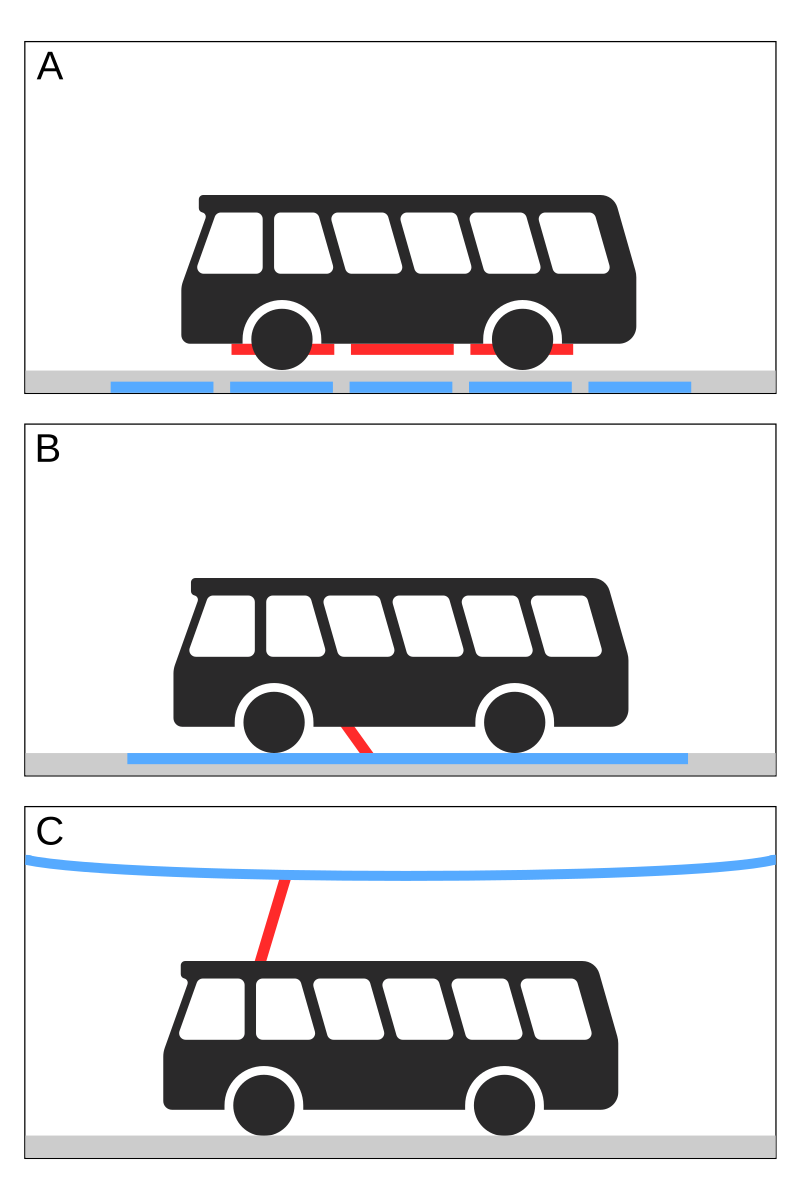 Three types of electric road systems. An electric bus (black) receives power from the road: (A) with three inductive pickups (red) from a strip of resonant inductive coils (blue) embedded several centimeters under the road (gray); (B) with a current collector (red) sliding over a ground-level power supply rail segment (blue) flush with the surface of the road (gray); (C) with an overhead current collector (red) sliding against a powered overhead line (blue) An electric road system (ERS) is a road which supplies electric power to vehicles travelling on it. Common implementations are overhead power lines above the road, ground-level power supply through conductive rails, and dynamic wireless power transfer (DWPT) through resonant inductive coils or inductive rails embedded in the road. Overhead power lines are limited to commercial vehicles while ground-level rails and inductive power transfer can be used by any vehicle, which allows for public charging through a power metering and billing systems. Of the three methods, ground-level conductive rails are estimated to be the most cost-effective.[161]: 10–11 National electric road projects Government studies and trials have been conducted in several countries seeking a national electric road network. Korea was the first to implement an induction-based public electric road with a commercial bus line in 2013 after testing an experimental shuttle service in 2009,[162]: 11–18 but it was shut down due to aging infrastructure amidst controversy over the continued public funding of the technology.[163] United Kingdom municipal projects in 2015[164] and 2021 found wireless electric roads financially unfeasible.[165] Sweden has been performing assessments of various electric road technologies since 2013 under the Swedish Transport Administration electric road program.[166]: 5 After receiving electric road construction offers in excess of the project's budget in 2023, Sweden pursued cost-reduction measures for either wireless or rail electric roads.[167] The project's final report was published in 2024, which recommended against funding a national electric road network in Sweden as it would not be cost-effective, unless the technology was adopted by its trading partners such as by France and Germany.[168][169] Germany found in 2023 that the wireless electric road system (wERS) by Electreon collects 64.3% of the transmitted energy, poses many difficulties during installation, and blocks access to other infrastructure in the road.[170] Germany trialed overhead lines in three projects and reported they are too expensive, difficult to maintain, and pose a safety risk.[171][172][173] France found similar drawbacks for overhead lines as Germany did. France began several electric road pilot projects in 2023 for inductive and rail systems.[174] Ground-level power supply systems are considered the most likely candidates.[175] Vehicle-to-grid: uploading and grid buffering Main article: Vehicle-to-grid During peak load periods, when the cost of generation can be very high, electric vehicles with vehicle-to-grid capabilities could contribute energy to the grid. These vehicles can then be recharged during off-peak hours at cheaper rates while helping to absorb excess night time generation. The batteries in the vehicles serve as a distributed storage system to buffer power.[176] |
電気道路 主な記事 電気道路  3種類の電気道路システム。電気バス(黒)が道路から電力を受け取る:(A)道路(灰色)の下数センチに埋め込まれた帯状の共振誘導コイル(青)から3つ の誘導ピックアップ(赤)、(B)道路(灰色)の表面と同じ高さの地上給電レールセグメント(青)の上を滑る集電装置(赤)、(C)電力を供給する架線 (青)に対して滑る架空集電装置(赤)。 電気道路システム(ERS)は、走行する車両に電力を供給する道路である。一般的な実装は、道路上部の架空送電線、導電性レールによる地上送電、共振誘導 コイルや道路に埋め込まれた誘導レールによる動的無線電力伝送(DWPT)である。架空送電線は商用車に限られるが、地上導電レールと誘導送電はどのよう な車両でも利用でき、電力メーターと課金システムによる公共充電が可能になる。3つの方法のうち、地上導電レールが最も費用対効果が高いと推定されている [161]: 10-11 国民電気道路プロジェクト 国民電気道路網を目指して、いくつかの国で政府による研究や試験が行われている。 韓国は、2009年に実験的なシャトル・サービスをテストした後、2013年に商業バス路線で誘導ベースの公共電気道路を初めて実施した[162]: 11-18だが、技術への公的資金投入の継続をめぐって論争が起こる中、インフラの老朽化により閉鎖された[163]。 2015年[164]と2021年のイギリスの自治体のプロジェクトでは、ワイヤレス電気道路は財政的に実現不可能であることが判明した[165]。 スウェーデンは、スウェーデン運輸管理局の電気道路プログラムのもと、2013年から様々な電気道路技術の評価を行っている[166]: 5 2023年にプロジェクトの予算を上回る電気道路建設の提案を受けた後、スウェーデンは無線電気道路か鉄道電気道路のコスト削減策を追求した[167]。 プロジェクトの最終報告書は2024年に公表され、フランスやドイツなどの貿易相手国が技術を採用しない限り、費用対効果が見込めないとして、スウェーデ ンの国民電気道路網に資金を提供することに反対するよう勧告した[168][169]。 ドイツは2023年に、Electreon社によるワイヤレス電気道路システム(wERS)が送電エネルギーの64.3%を収集し、設置時に多くの困難を もたらし、道路内の他のインフラへのアクセスを阻害することを発見した[170]。ドイツは3つのプロジェクトで架空線を試行し、高すぎ、維持が困難であ り、安全上のリスクがあると報告した[171][172][173]。 フランスもドイツと同様の欠点を架空線に見出した。フランスは2023年に、誘導式とレール式のいくつかの電気道路パイロット・プロジェクトを開始した [174]。地上給電システムが最も可能性の高い候補と考えられている[175]。 ビークル・ツー・グリッド:アップロードとグリッド・バッファリング 主な記事 ビークル・ツー・グリッド 発電コストが非常に高くなるピーク負荷期間には、ビークル・ツー・グリッド機能を持つ電気自動車が送電網にエネルギーを供給することができる。これらの電 気自動車は、オフピーク時に安い料金で充電することができ、夜間の余剰発電を吸収するのに役立つ。車両に搭載されたバッテリーは、電力をバッファリングす る分散型蓄電システムとして機能する[176]。 |
| Lifespan Main article: Rechargeable battery § Lifespan and cycle stability As with all lithium-ion batteries, electric vehicle batteries may degrade over long periods of time, especially if they are frequently charged to 100%; however, this may take at least several years before being noticeable.[177] A typical warranty is 8 years or 100,000 mi (160,000 km),[178] but for non-professional drivers mileage may not be relevant, and the batteries usually last much longer,[179] perhaps 15 to 20 years in the car and then more years in another use.[180] |
寿命 主な記事 二次電池§寿命とサイクル安定性 すべてのリチウムイオンバッテリーと同様に、電気自動車のバッテリーは、特に頻繁に100%まで充電された場合、長期間にわたって劣化する可能性がある。 一般的な保証は8年または100,000マイル(160,000km)であるが[178]、プロフェッショナルではないドライバーにとっては走行距離は関 係ないかもしれず、バッテリーは通常はるかに長持ちする[179]。 |
Currently available electric cars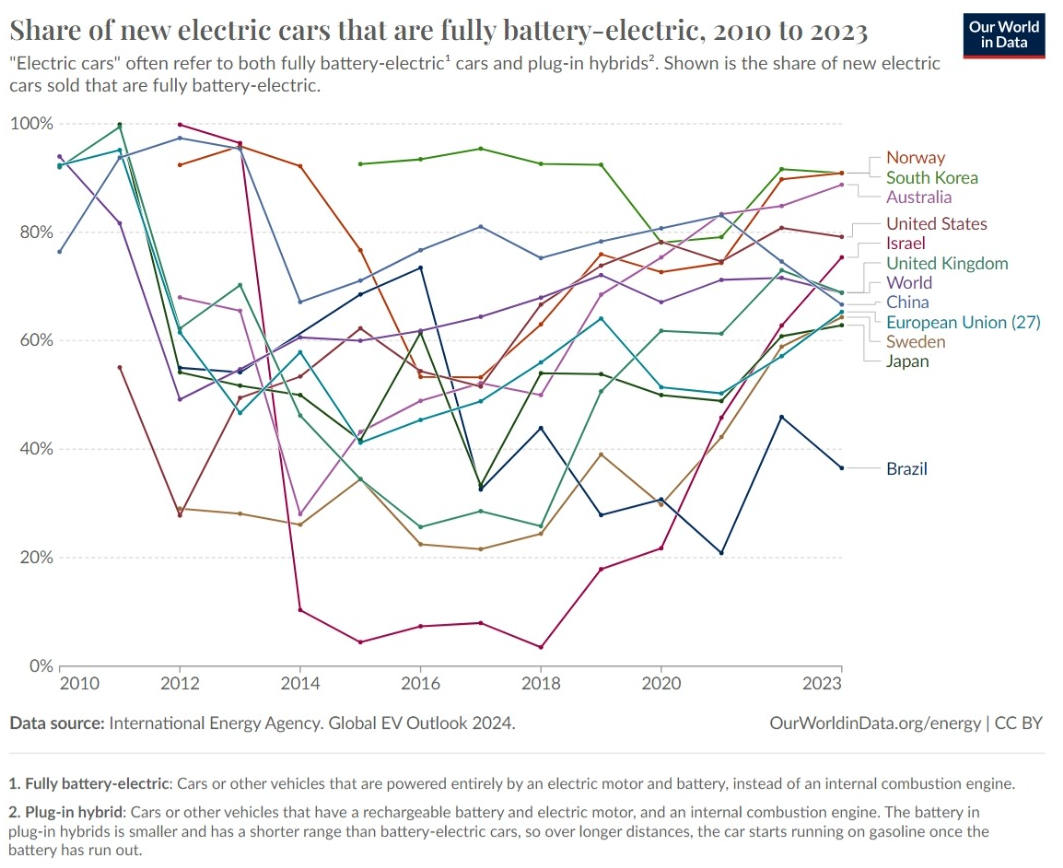 Share of new cars sold that are battery-electric and plug-in hybrid, 2010 to 2023 for selected countries. Sales of electric cars Main article: List of production battery electric vehicles Tesla became the world's leading electric vehicle manufacturer in December 2019.[181][182] Its Model S was the world's top selling plug-in electric car in 2015 and 2016,[183][184] its Model 3 has been the world's best selling plug-in electric car for four consecutive years, from 2018 to 2021, and the Model Y was the top selling plug-in car in 2022.[185][186][187][188][189] The Tesla Model 3 surpassed the Leaf in early 2020 to become the world's cumulative best selling electric car.[19] Tesla produced its 1 millionth electric car in March 2020, becoming the first auto manufacturer to do so,[190] and in June 2021, the Model 3 became the first electric car to pass 1 million sales.[20] Tesla has been listed as the world's top selling plug-in electric car manufacturer, both as a brand and by automotive group for four years running, from 2018 to 2021.[186][191][192][193][187] At the end of 2021, Tesla's global cumulative sales since 2012 totaled 2.3 million units,[194] with 936,222 of those delivered in 2021.[195] BYD Auto is another leading electric vehicle manufacturer, with the majority of its sales coming from China. From 2018 to 2023, BYD produced nearly 3.18 million purely plug-in electric car, with 1,574,822 of those were produced in 2023 alone.[196] In the fourth quarter of 2023, BYD surpassed Tesla as the top-selling electric vehicle manufacturer by selling 526,409 battery electric cars, while Tesla delivered 484,507 vehicles.[197][198] As of December 2021, the Renault–Nissan–Mitsubishi Alliance listed as one of major all-electric vehicle manufacturers, with global all-electric vehicle sales totaling over 1 million light-duty electric vehicles, including those manufactured by Mitsubishi Motors since 2009.[199][200] Nissan leads global sales within the Alliance, with 1 million cars and vans sold by July 2023,[201] followed by the Groupe Renault with more than 397,000 electric vehicles sold worldwide through December 2020, including its Twizy heavy quadricycle.[202] As of July 2023, global sales totaled over 650,000 units since inception.[201] Other leading electric vehicles manufacturers are GAC Aion (part of GAC Group, with 962,385 cumulative sales as of December 2023),[203] SAIC Motor with 1,838,000 units (as of July 2023), Geely, and Volkswagen.[204][205][206][207][208] The following table lists the all-time best-selling highway-capable all-electric cars with cumulative global sales of over 250,000 units: |
現在販売されている電気自動車 2010年から2023年に販売された新車のうち、バッテリー式電気自動車とプラグイン・ハイブリッド車が占める割合。 電気自動車の販売台数 主な記事 市販バッテリー電気自動車リスト テスラは2019年12月に世界トップの電気自動車メーカーとなった[181][182]。同社のモデルSは2015年と2016年に世界で最も売れたプ ラグイン電気自動車であり[183][184]、モデル3は2018年から2021年まで4年連続で世界で最も売れたプラグイン電気自動車であり、モデル Yは2022年に最も売れたプラグイン自動車であった。 [185][186][187][188][189]テスラ・モデル3は2020年初頭にリーフを上回り、電気自動車の累計販売台数で世界一となった。 [19]テスラは2020年3月に100万台目の電気自動車を生産し、自動車メーカーとして初めて100万台目を達成し[190]、2021年6月にはモ デル3が電気自動車として初めて販売台数100万台を突破した。 [20] テスラは、2018年から2021年まで4年連続で、ブランドとしても自動車グループ別としても、プラグイン電気自動車の販売台数で世界トップに挙げられ ている[186][191][192][193][187] 2021年末時点で、テスラの2012年からの世界累計販売台数は230万台となり[194]、そのうち93万6222台が2021年に納車された [195]。 BYD Autoは、もう一つの主要な電気自動車メーカーであり、その販売の大部分は中国からもたらされている。2018年から2023年まで、BYDは約318 万台の純粋なプラグイン電気自動車を生産し、そのうち157万4,822台は2023年だけで生産された[196]。2023年の第4四半期には、BYD は52万6,409台のバッテリー電気自動車を販売し、電気自動車メーカーのトップセラーとしてテスラを上回ったが、テスラは48万4,507台を納入し た[197][198]。 2021年12月の時点で、ルノー・日産・三菱アライアンスは、2009年以降三菱自動車によって製造されたものを含め、世界の全電気自動車販売台数が 100万台を超える小型電気自動車を製造しており、主要な全電気自動車メーカーのひとつに挙げられている。 [199][200]日産は、2023年7月までに100万台の自動車とバンを販売し、アライアンス内の世界販売台数でトップであり[201]、次いでグ ループ・ルノーは、2020年12月までに、大型四輪自転車Twizyを含む397,000台以上の電気自動車を世界で販売している[202]。 他の主要な電気自動車メーカーは、GAC Aion(GACグループ傘下、2023年12月時点の累計販売台数は962,385台)[203]、SAIC Motorの1,838,000台(2023年7月時点)、吉利汽車、フォルクスワーゲンである[204][205][206][207][208]。 以下の表は、累計世界販売台数が25万台を超える、高速道路対応の全電気自動車の歴代ベストセラーの一覧である: |
| All-time top-selling
highway-capable(1) all-electric passenger car nameplates |
All-time top-selling
highway-capable(1) all-electric passenger car nameplates 【省略】 |
| Electric cars by country Main article: electric car use by country In the year of 2021, the total number of electric cars on the world's roads went to about 16.5 million. The sales of electric cars in the first quarter of 2022 went up to 2 million.[246] China has the largest all-electric car fleet in use, with 2.58 million at the end of 2019, more than half (53.9%) of the world's electric car stock. All-electric cars have oversold plug-in hybrids since 2012.[247][188][189][248] 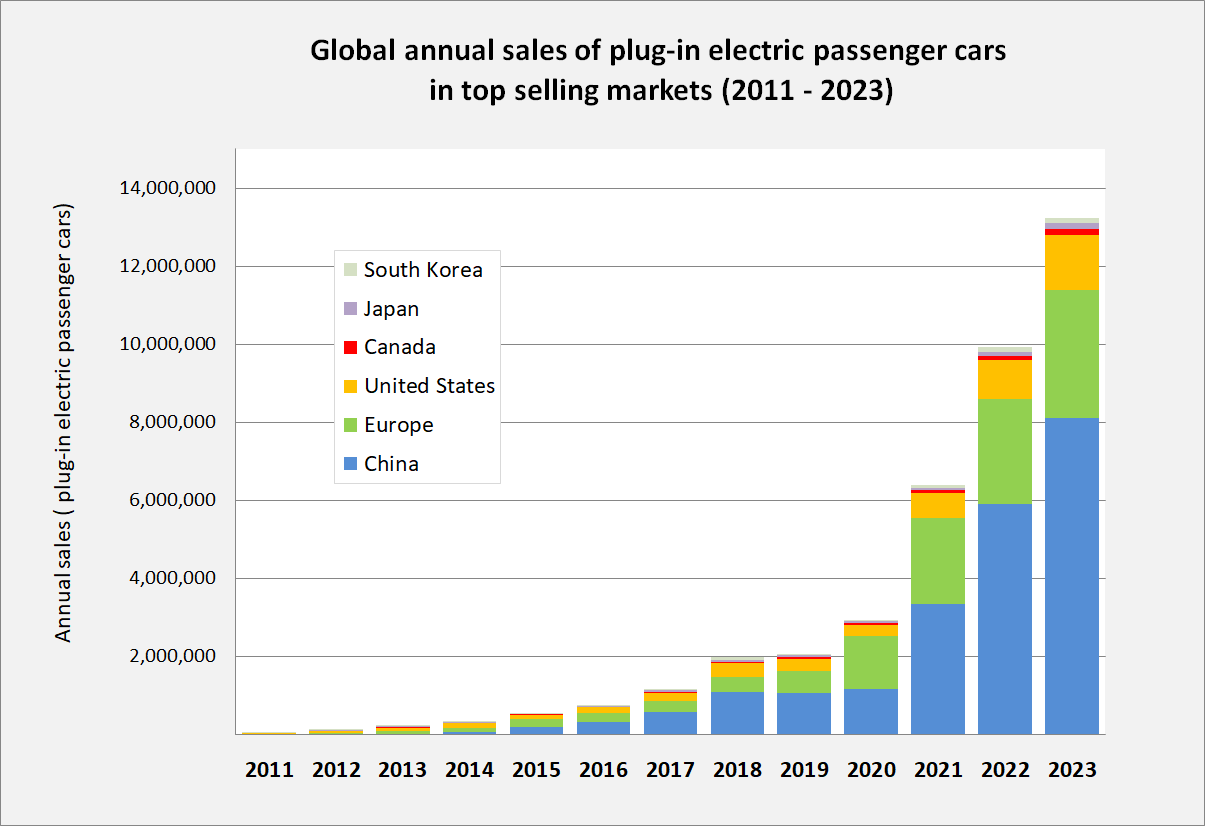 Annual sales of plug-in electric passenger cars in the world's top markets between 2011 and 2023[249][250][251][252][253][254][255][256][257] 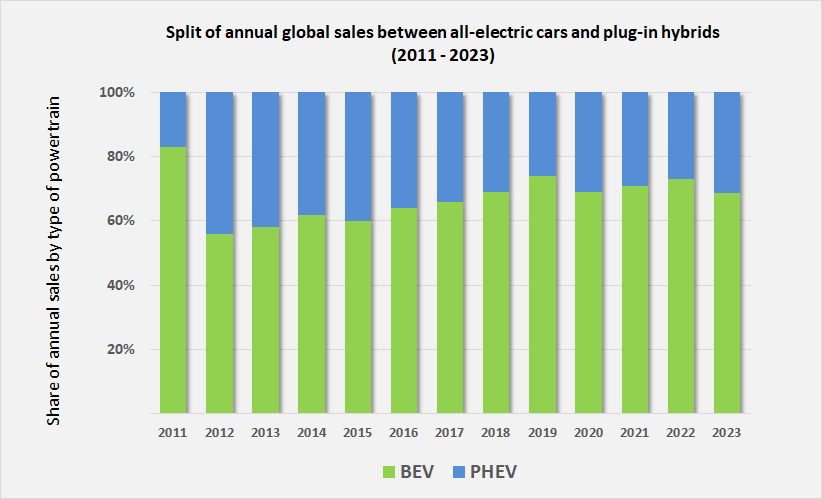 Evolution of the ratio between global sales of BEVs and PHEVs between 2011 and 2023[247][188][189][258][259][248] |
国別の電気自動車 主な記事:国別の電気自動車利用 2021年、世界の道路を走る電気自動車の総数は約1,650万台に達した。2022年第1四半期の電気自動車の販売台数は200万台に達した [246]。中国は、2019年末時点で258万台と、世界の電気自動車ストックの半分以上(53.9%)を占め、使用されている全電気自動車台数が最大 である。 2012年以降、オール電化車はプラグイン・ハイブリッド車を上回っている[247][188][189][248]。  2011年から2023年までの世界のトップ市場におけるプラグイン電気乗用車の年間販売台数[249][250][251][252][253] [254][255][256][257]。  2011~2023年におけるBEVとPHEVの世界販売台数比率の推移[247][188][189][258][259][248] |
Government policies and
incentives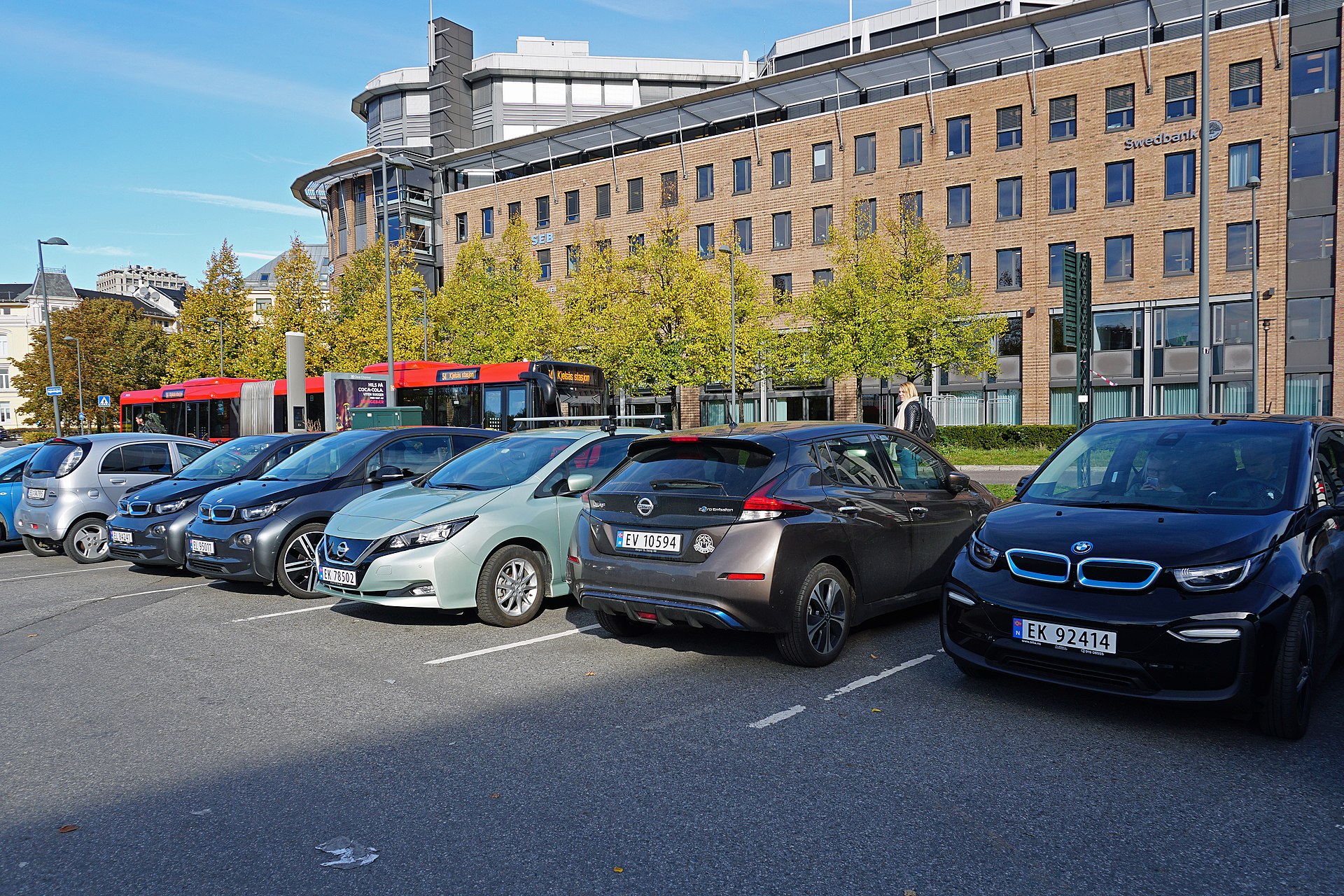 A dedicated electric car free charging and parking lot in Oslo Main article: Government incentives for plug-in electric vehicles See also: Phase-out of fossil fuel vehicles 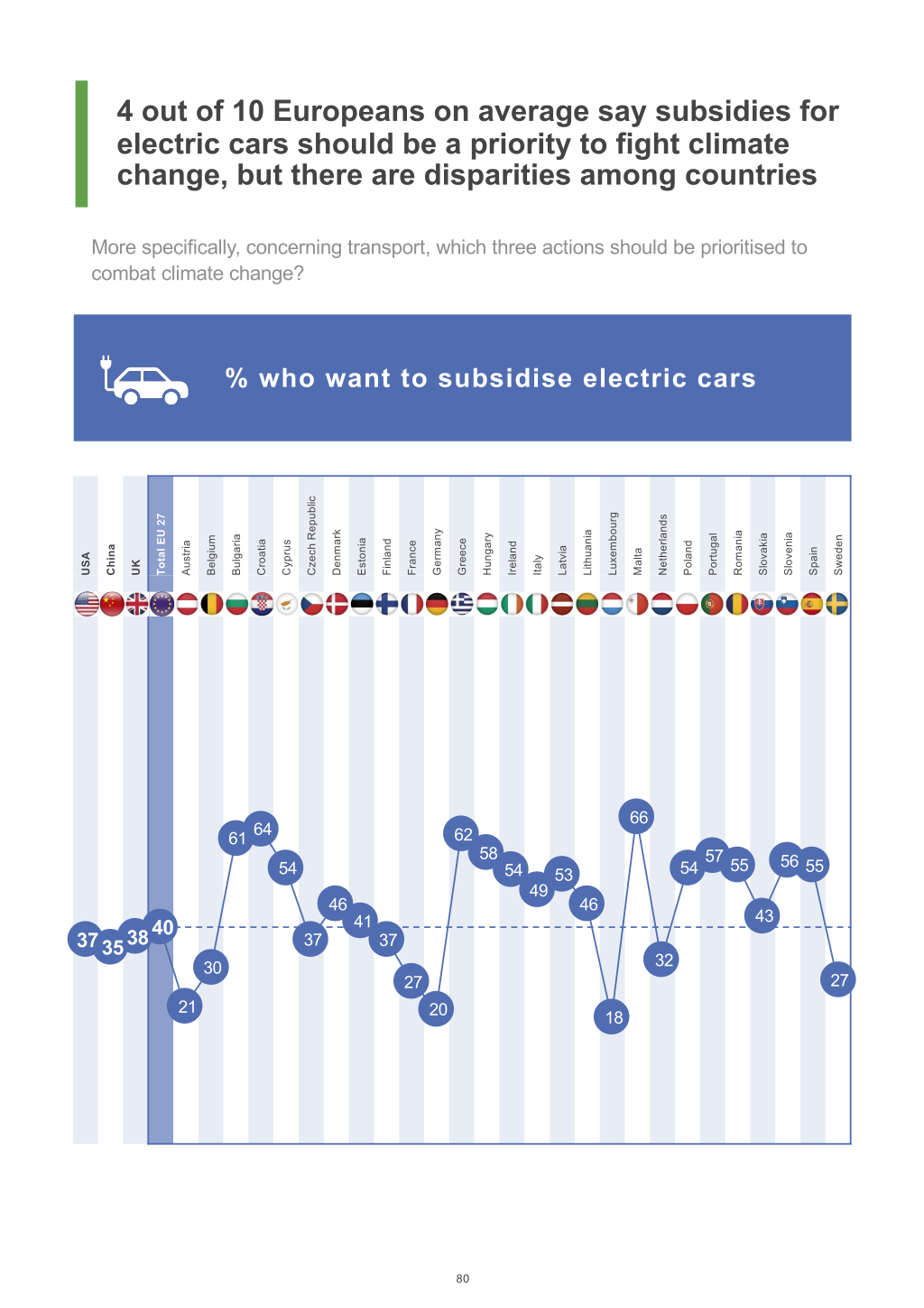 Four out of ten Europeans interviewed for the European Investment Bank climate survey thought subsidies for electric cars should be a priority to fight climate change. Several national, provincial, and local governments around the world have introduced policies to support the mass-market adoption of plug-in electric vehicles. A variety of policies have been established to provide: financial support to consumers and manufacturers; non-monetary incentives; subsidies for the deployment of charging infrastructure; electric vehicle charging stations in buildings; and long-term regulations with specific targets.[250][260][261] 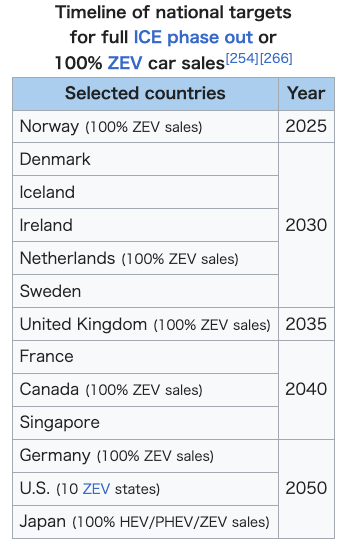 Timeline of national targets for full ICE phase out or 100% ZEV car sales[250][262] Selected countries Year Norway (100% ZEV sales) 2025 Denmark 2030 Iceland Ireland Netherlands (100% ZEV sales) Sweden United Kingdom (100% ZEV sales) 2035 France 2040 Canada (100% ZEV sales) Singapore Germany (100% ZEV sales) 2050 U.S. (10 ZEV states) Japan (100% HEV/PHEV/ZEV sales) Financial incentives for consumers are aiming to make electric car purchase price competitive with conventional cars due to the higher upfront cost of electric vehicles. Depending on battery size, there are one-time purchase incentives such as grants and tax credits; exemptions from import duties; exemptions from road tolls and congestion charges; and exemption of registration and annual fees. Among the non-monetary incentives, there are several perks such allowing plug-in vehicles access to bus lanes and high-occupancy vehicle lanes, free parking and free charging.[260] Some countries or cities that restrict private car ownership (for example, a purchase quota system for new vehicles), or have implemented permanent driving restrictions (for example, no-drive days), have these schemes exclude electric vehicles to promote their adoption.[263][264][265][266][267][268] Several countries, including England and India, are introducing regulations that require electric vehicle charging stations in certain buildings.[261][269][270] Some government have also established long term regulatory signals with specific targets such as zero-emissions vehicle (ZEV) mandates, national or regional CO2 emission regulations, stringent fuel economy standards, and the phase out of internal combustion engine vehicle sales.[250][260] For example, Norway set a national goal that by 2025 all new car sales should be ZEVs (battery electric or hydrogen).[271][272] While these incentives aim to facilitate a quicker transition from internal combustion cars, they have been criticized by some economists for creating excess deadweight loss in the electric car market, which may partially counteract environmental gains.[273][274][275] |
政府の政策とインセンティブ オスロの電気自動車専用無料充電・駐車場 主な記事 プラグイン電気自動車に対する政府の優遇措置 以下も参照のこと: 化石燃料自動車の段階的廃止  欧州投資銀行(EIB)が行った気候に関する調査では、ヨーロッパ人の10人中4人が、気候変動対策として電気自動車への補助金を優先すべきと考えてい た。 世界のいくつかの国民政府、州政府、地方政府は、プラグイン電気自動車の大量市場導入を支援する政策を導入している。消費者やメーカーに対する財政的支 援、金銭以外のインセンティブ、充電インフラ配備に対する補助金、建物内の電気自動車充電ステーション、特定の目標を定めた長期的規制など、さまざまな政 策が打ち出されている[250][260][261]。 国民目標のタイムライン ICE完全廃止または 100%ZEV車販売[250][262]に向けた国家目標のタイムライン[250][262]。  年 ノルウェー(100%ZEV販売) 2025年 デンマーク 2030 アイスランド アイルランド オランダ(100%ZEV販売) スウェーデン イギリス(100% ZEV 販売) 2035 フランス 2040 カナダ(100% ZEV 販売) シンガポール ドイツ(100% ZEV 販売) 2050 米国 (ZEV 10 州) 日本(100%HEV/PHEV/ZEV販売) 電気自動車は初期費用が高いため、消費者に対する経済的インセンティブは、電気自動車の購入価格を従来型自動車と比較して競争力のあるものにすることを目 指している。バッテリーの大きさに応じて、補助金や税額控除、輸入関税の免除、道路通行料や渋滞料金の免除、登録料や年会費の免除など、1回限りの購入優 遇措置がある。 金銭以外のインセンティブとしては、プラグイン車によるバス専用レーンや高車両専用レーンの利用、無料駐車場、無料充電などの特典がある[260]。自家 用車の保有を制限している国や都市(例えば、新車購入枠制度など)、または恒久的な走行制限(例えば、ノー・ドライブ・デーなど)を実施している国や都市 では、電気自動車の普及を促進するために、これらの制度を電気自動車から除外している。 [263][264][265][266][267][268]。イギリスやインドを含むいくつかの国では、特定の建物に電気自動車の充電ステーションを 義務付ける規制を導入している[261][269][270]。 一部の政府はまた、ゼロ・エミッション車(ZEV)の義務付け、国民または地域のCO2排出規制、厳しい燃費基準、内燃エンジン車の販売段階的廃止など、 具体的な目標を掲げた長期的な規制シグナルを設定している。 [250][260]例えば、ノルウェーは、2025年までにすべての新車販売をZEV(バッテリー電気自動車または水素自動車)にするという国民目標を 設定した[271][272]。こうしたインセンティブは、内燃自動車からの移行を迅速に促進することを目的としているが、一部のエコノミストからは、電 気自動車市場に過剰なデッドウェイト・ロスを生み出し、環境面での利益を部分的に打ち消す可能性があるという批判を受けている[273][274] [275]。 |
| EV plans from major manufacturers This article has multiple issues. Please help improve it or discuss these issues on the talk page. (Learn how and when to remove these messages) This section needs to be updated. (April 2024) The examples and perspective in this section deal primarily with outside China and do not represent a worldwide view of the subject. (August 2021) Electric vehicles (EVs) have gained significant traction as an integral component of the global automotive landscape in recent years. Major automakers from around the world have adopted EVs as a critical component of their strategic plans, indicating a paradigm shift toward sustainable transportation. 【以下省略】 |
主要メーカーのEV計画 この記事には複数の問題がある。改善の手助けをするか、トークページでこれらの問題について議論してほしい。(これらのメッセージを削除する方法とタイミ ングを学ぶ) このセクションは更新する必要がある。(2024年4月) このセクションの例と視点は、主に中国国外を扱ったものであり、このテーマに関する世界的な見解を示すものではない。(2021年8月) 電気自動車(EV)は近年、世界の自動車事情に不可欠な要素として大きな支持を得ている。世界中の大手自動車メーカーがEVを戦略計画の重要な要素として 採用し、持続可能な輸送手段へのパラダイムシフトを示している。 【以下省略】 |
| Forecasts Total global EV sales in 2030 were predicted to reach 31.1 million by Deloitte.[303] The International Energy Agency predicted that the total global stock of EVs would reach almost 145 million by 2030 under current policies, or 230 million if Sustainable Development policies were adopted.[304] As of 2024, there are approximately 600 million people in sub-Saharan Africa without access to electricity, representing 83% of the world's unelectrified population.[305] The World Bank Group and the African Development Bank plan to provide access to electricity to 300 million people in that region by 2030.[305] At this time, there are just over 20,000 electric vehicles and less than 1,000 charging stations in Africa.[306] However, EV manufacturers have already built or are planning to build production plants in 21 African countries.[306] |
予測 国際エネルギー機関(IEA)は、EVの世界総ストックは、現在の政策下では2030年までにほぼ1億4,500万台に達し、持続可能な開発政策が採用さ れた場合は2億3,000万台に達すると予測した[304]。 2024年時点で、サハラ以南のアフリカには電気を利用できない人々が約6億人おり、これは世界の無電化人口の83%に相当する[305]。世界銀行グ ループとアフリカ開発銀行は、2030年までに同地域の3億人に電気を利用できるようにすることを計画している[305]。現時点では、アフリカには電気 自動車が2万台強、充電ステーションが1,000未満しかない[306]。しかし、EVメーカーはアフリカ21カ国にすでに生産工場を建設しているか、建 設を計画している[306]。 |
| Electric vehicle Battery electric vehicle Plug-in electric vehicle Plug-in hybrid electric vehicle Electric bus Electric rickshaw Solar car Electric car energy efficiency Electric motorcycles and scooters Electric vehicle warning sounds - vehicle sounds for pedestrian safety Electric motorsport Eco Grand Prix Formula E List of electric cars currently available Vehicle-to-everything (V2X) Phase-out of fossil fuel vehicles Personal electric vehicle (PEV) |
電気ヴィークル(乗り物) バッテリー電気自動車 プラグイン電気自動車 プラグインハイブリッド電気自動車 電気バス 電気人力車 ソーラーカー 電気自動車のエネルギー効率 電動バイクとスクーター 電気自動車の警告音 - 歩行者の安全のための車両音 電気モータースポーツ エコグランプリ フォーミュラE 現在販売されている電気自動車のリスト ビークル・ツー・エブリシング(V2X) 化石燃料自動車の段階的廃止 人格電気自動車(PEV) |
| https://en.wikipedia.org/wiki/Electric_car |
How
does an Electric Car work ? | Tesla Model S
Copyleft,
CC, Mitzub'ixi Quq Chi'j, 1996-2099